NAMES OF THE WEEK from: 2013 2014 2015 2016 2017 2018 2019 2021 2022 2023 2024
30 December
The meteorite, the museum, the fire, and the catfish

The Bendegó meteorite at Museu Nacional (before the fire).
The Bendegó meteorite is the second-largest meteorite found in Brazil. It was discovered in 1784 by a boy who was grazing cattle on a farm near the present town of Monte Santo in Bahia State. Based on the four-inch layer of oxidation upon which it rested, it had crashed to Earth thousands of years prior. Moving it was difficult due to its weight (5,360 kg). It fell off a cart, down a hill, and into a dry stream bed 180 meters away from where it was found. It remained there until 1888, when it was recovered and brought to the Museu Nacional — the National Museum of Brazil in Rio de Janeiro — in 1888.
The Museu Nacional, founded in1818) is Brazil’s oldest scientific institution. The main building — the “palace” — was originally the residence of the Portuguese royal family between 1808 and 1821. It was converted for museum use in 1892. Over the decades it amassed a vast collection with more than 20 million natural history and anthropological objects, and a scientific library of over 470,000 volumes and rare works. The collection was the principal research center for Brazilian paleontologists, botanists, anthropologists, archaeologists, ethnologists, and zoologists.
The “palace” was destroyed in a fire on the night of 2 September 2018. Faced with budget cuts — including 90% of its maintenance budget — the museum had fallen into disrepair. Peeling paint, termites and exposed wiring were among its many problems. Critics called it a “firetrap.” And it was. The fire began in the air-conditioning system of the auditorium on the ground floor when an exposed wire came in contact with metal. The museum lacked a sprinkler system and firefighters were hindered by poor water pressure in nearby fire hydrants. To fight the blaze they had to pump water from a nearby lake.
Approximately 92.5% of the museum’s collection was destroyed. (The fish and reptile collections and the herbarium, housed off-site, were not affected.) The building was uninsured. The Bendegó meteorite survived the fire due to its inherent fire resistance.

Microcambeva bendego. From: Medieros et al. 2020. A new catfish species of Microcambeva Costa & Bockmann 1994 (Siluriformes: Trichomycteridae) from a coastal basin in Rio de Janeiro State, southeastern Brazil. Zootaxa 4895 (1): 111–123.
Two years before the fire, in August 2016, ichthyologists collected a new species of psammophilous (sand loving), translucent catfish from the rio Guapi-Macacu basin at Guanabara Bay in Rio de Janeiro State, Brazil. Guanabara Bay occurs in the Atlantic Forest, a biodiversity hotspot that extends along the Atlantic Coast of Brazil. Over 85% has been destroyed, threatening many plant and animal species with extinction, including this catfish.
Two weeks ago, on 14 December, the scientific description of this catfish was published in the journal Zootaxa. The authors — Lucas Silva de Medeiros, Cristiano Rangel Moreira, Mário de Pinna and Maia Quiroz Lima — named it Microcambeva bendego, after the meteorite that survived the fire. The authors explained:
Even though part of the building collapsed, the Bendegó remained intact at the main entrance of the museum, where it was seen by the crowd that gathered the day after the fire, becoming a symbol of the resistance of the institution. This is not only an homage to the MNRJ [Museu Nacional, Universidade Federal do Rio de Janeiro], its employees and students, but also an allusion to the resilience of the species herein described in Atlantic Forest basin severely impacted by anthropic actions.
The museum, funded in part by donations from all over the world, is being rebuilt. But nothing can replace the 200 years of work, research, knowledge, and priceless artifacts that were lost.
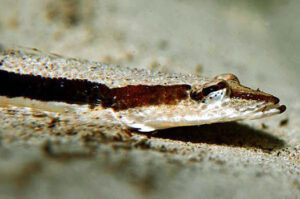
Enigmapercis reducta, at night near the Port Victoria jetty, South Australia, depth 1 m, January 2013. Source: David Muirhead. Courtesy: https://fishesofaustralia.net.au
23 December
Enigmapercis reducta Whitley 1936
Australian ichthyologist Gilbert Percy Whitley (1903-1975) has been a constant source of material for the “Name of the Week.” He was a master of the enigmatic fish name. Here’s one that is literally enigmatic.
Enigmapercis reducta, the Broad Duckbill, inhabits sandy areas near reefs on the southern half of Australia. It usually lies buried in the sand with only its eyes exposed. Whitley proposed both the genus and the species in 1936, in a very brief account. He followed up with a more detailed description a year later. As per his custom, he did not provide an etymology, but we can reasonably assume that the specific epithet reducta refers to the first anatomical feature he mentioned in his 1937 paper: “A genus of small fishes … in which the spinous dorsal fin is reduced to a couple of small spines connected to the back by membrane and well separated from the soft dorsal fin.” “Reducta” could also mean remote, referring to how the spinous and soft dorsal fins are separated.
The generic name Enigmapercis is just that — enigmatic. The percis, or perch, half of the name may refer to Whitley’s placement of the species in the family Parapercidae (now a synonym of Pinguipedidae in the stargazer order Uranoscopiformes). Today the genus is placed in the signalfish family Hemerocoetidae in the order Pempheriformes. But what does the enigma part mean? What did Whitley find enigmatic about this fish?
In his 1937 paper, Whitley recorded his observations of the holotype, which was still alive when he received it:
“This specimen was brought to the [Australian] Museum alive in a small bottle, together with dredged gravel and shells, which it imitated in coloration to a surprising degree. It lay on the bottom and, to increase the disguise, placed some of the shells on its head and shoulders by flicking with its pectoral fins. It was very hardy, living for a surprising time even in formalin.”
Considering that “enigmatic” can also mean puzzling, perplexing and inexplicable, did Whitley name the species for the inexplicability of a fish disguising itself in a bottle … and then living for a short while in formalin?
Even if Whitley were alive today, he may not divulge the secrets of his names. According to goby taxonomist Helen Larson, Whitley hardly ever gave derivations for his names, “even when asked.”

Cantherhines verecundus, photographed by the great Jack Randall himself. Courtesy: FishBase.
16 December
Cantherhines verecundus Jordan 1925
Far be it from us to challenge the authority of the late John “Jack” Randall (1924-2020), fin for fin, scale for scale, one of the greatest ichthyologists ever. But when it came to explaining the etymology of the specific epithet of Cantherhines verecundus, he was off the mark.
Cantherhines verecundus is a filefish (Tetraodontiformes: Monocanthidae) from the Hawaiian Islands. In his 2011 review of the genus, Randall wrote that “verecundus” means “modest or shy, which is appropriate because this fish is difficult to approach underwater.” No human being has spent more time diving in these waters observing and photographing its fishes. So if Randall says the fish is shy, then it is unquestionably shy. In fact, the fish’s common name is Shy Filefish.
Apparently, however, Randall did not carefully consider Jordan’s original description from 1925. Jordan said the name means “modest,” which, of course, can mean shy or bashful, but other things as well, such as moderate or unassuming. Jordan did not explain why he selected the name. Nor did he mention the fish’s shy or bashful behavior, presumably because he never saw the fish in life. Jordan described the species from seven specimens obtained at a fish market in Honolulu. What’s more, knowing that the fish was shy or bashful when approached by divers would require diving. In 1925, scuba diving had not yet been invented.
What Jordan did describe was the fish’s colors as compared to the closely related and more common C. sandwichiensis, also from Hawaii. Jordan said C. verecundus has a “dull olive” body, “mottled and clouded,” and “paler olive” fins. C. sandwichiensis, however, has a darker body, “usually with small round black spots more or less numerous on head and anterior parts,” with higher dorsal and anal fins that are a “bright orange red in life.”
Based on this comparison, and the fact that Jordan could not have observed this filefish in situ, it seems a pretty good bet that Jordan’s selection of the adjective “verecundus” refers to its modest, less showy coloration compared to C. sandwichiensis.
Sad footnote: Jordan is not the famous American ichthyologist David Starr Jordan (1851-1931), but his son Eric Knight. Six months after Jordan’s description of C. verecundus was published — and just one month after his wedding — he was killed when his car overturned on route to a geological survey in California. Eric Knight Jordan was 22 years old.
References:
Jordan, E. K. 1925. Notes on the fishes of Hawaii, with descriptions of six new species. Proceedings of the United States National Museum v. 66 (no. 2570): 1-43, Pls. 1-2.
Randall, J. E. 2011. Review of the circumtropical monacanthid fish genus Cantherhines, with descriptions of two new species. Indo-Pacific Fishes No. 40: 1-30, Pls. 1-7.
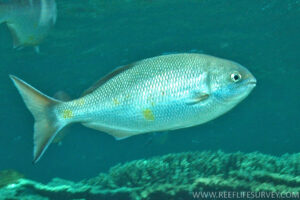
Kyphosus cornelii, at the Abrolhos Islands, Western Australia. Source: Graham Edgar / Reef Life Survey.
9 December
The fish named after a psychopath
I’ve always wondered who is the worst person ever honored in the name of a fish. Our candidates so far have been people honored for their scientific work yet who harbored beliefs considered offensive by today’s standards. Kyphosus cornelii, the Western Buffalo Bream of Western Australia, is an exception. It was named after a very bad person — indeed, an evil person — whose claim to fame are the atrocities he committed.
Jeronimus Cornelisz (also spelled Cornelius, born ca. 1598) was a Dutch apothecary. In 1627, his son died of syphilis, then considered a great scandal, especially for an apothecary. With his reputation damaged and his future business prospects bleak, Cornelisz joined the crew of the Dutch East India Company merchant ship Batavia, which set sail for Java in 1628.
For reasons unclear, Cornelisz and the ship’s skipper, Ariaen Jacobsz, began planning a mutiny. Jacobsz apparently sailed the ship off course, eventually running aground in 1629 on a coral reef at Houtman Abrolhos, a chain of 122 islands in the Indian Ocean off Western Australia. The survivors, some 200 of them, including many women and children, made their way ashore. There was no food, no shelter, and no drinking water. Many survivors did not survive for long. Already desperately sick from scurvy, dehydration quickly took its toll. Jacobsz and the ship’s officers left in the only boat, saying they were in search of water when they were actually fleeing the island on a month-long voyage to Java.
Left on the island, Cornelisz established himself as the leader. They caught fish and collected rain water, but there wasn’t enough to go around. In order to stretch their rations, Cornelisz and his henchmen began murdering the weakest and most vulnerable survivors. Anyone who refused or resisted Cornelisz’ orders was murdered as well. All told, Cornelisz and his henchmen killed between 110 and 124 men, women and children over a two-month period. Their victims were drowned, strangled, hacked to pieces, bludgeoned to death, or had their throats slit. Seven surviving women were forced into sexual slavery.
When a rescue ship arrived, Cornelisz and his men demonstrated that they did not want to be rescued. Instead, they tried to seize the ship, presumably to become pirates and expand their reign of terror throughout the Dutch East Indies. Outmanned and outgunned, they were taken into custody and tortured into confession. Cornelisz was tried on the island, found guilty of mutiny, and hanged along with six of his men. Both of his hands were amputated (per Dutch law at the time) prior to the hanging. Jacobsz reportedly died in a dungeon in Jakarta.
In the 2003 book Batavia’s Graveyard, author Mike Dash makes the case that Cornelisz was almost certainly a psychopath. The ruthless killings were less about survival, Dash argues, and more about Cornelisz’ desire to create his own personal kingdom. Like other psychopaths, Cornelisz believed he could do no wrong, and that God himself inspired his evil deeds.
In 1944, Australian ichthyologist Gilbert Percy Whitley described a new species of sea chub (Kyphosidae) from Houtman Abrolhos, the same chain of islands where the Batavia was lost, and so many people murdered, in 1629. Whitley named the fish Segutilum (now Kyphosus) cornelii, after the “villain” (his word, which he placed in quotes) of the Batavia mutiny.
Personally, I find Whitley’s selection tone-deaf and distasteful. It’s appropriate to link the fish’s type locality with the islands’ infamous place in history. But why honor the man who committed these atrocities? Why not honor the ship, or the men, women and children who suffered and died on that island? Jeronimus Cornelisz represents the worst of humanity. I don’t like it that he’s commemorated in the name of a lovely fish.
 2 December
2 December
Astatotilapia flaviijosephi (Lortet 1883)
In the September 2020 issue of Buntbarsche Bulletin, the journal of the American Cichlid Association, Paul Loiselle summarizes the aquarium husbandry of Astatotilapia flaviijosephi, the Jordan Mouthbrooder. As its common name suggests, it’s endemic to the central Jordan River system, including Lake Tiberias (also known as Kinneret), of Israel, Jordan and Syria. In fact, A. flaviijosephi is the only haplochromine cichlid that naturally occurs outside of Africa.
Loiselle includes in his article a brief side essay, “Who Was Flavius Josephus and Why Is a Cichlid Named After Him?” He answered the first of the two questions. Titus Flavius Josephus (37-c. 100), born Yosef ben Matityahu, was a prominent Romano-Jewish scholar, historian and hagiographer, most famous for his book The Wars of the Jews, or History of the Destruction of Jerusalem (also known as The Jewish War).
But Loiselle did not really answer the second question — why Louis Charles Émile Lortet (1836-1909), a physician, botanist, zoologist, paleontologist, Egyptologist and anthropologist, named Chromis (now Astatotilapia) flaviijosephi after a scholar from the first century A.D.
Loiselle wrote: “Educated persons living in the 19th Century were quite familiar with classical literature. Lortet appears to have shared the generally high regard in which the Jewish historian’s writings were held. In his monograph on the fishes of the Levant, he saw fit to express his admiration by naming a distinctive representative of that ichthyofauna in his honor. Lorter’s [sic] use of a patronymic as the species name for this cichlid is echoed in the contemporary Israeli vernacular amnunit yosef (Joseph’s tilapia).”
What Loiselle did not explain is that Lortet was more than just at admirer of Josephus’ historical writings. Lortet actually cited Josephus in his 1883 zoological survey of Lake Tiberias. Josephus had reported a thriving fishing industry on the lake, and mentioned a fish the Romans called “Coracinus.” Lortet identified this fish as Clarias macracanthus, now known as C. gariepinus, one of the air-breathing or “walking” catfishes of the family Clariidae. C. gariepinus widely occurs throughout Africa and the Middle East in just about everywhere there’s fresh water — lakes, rivers, swamps, man-made ponds, even urban sewage systems. “This remarkable catfish,” Lortet wrote, “often grows over 1 meter in length, and when caught and thrown on the sand, it will utter hoarse cries that resemble the meows of an angry cat” (translation). Lortet also saw fit to mention (twice, in fact) that Josephus believed the presence of “Coracinus” in Lake Tiberias was due to an underground connection with the Nile!
Lortet, however, may have been mistaken. Smithsonian ichthyologist Theodore Gill believes that Lortet misidentified Josephus’ “Coracin fish.” The name “Coracinus” dates to Aristotle and has historically been applied to a number of perch-like fishes over the centuries, including drums, damselfishes and, yes, cichlids. Gill believes the fish mentioned in Josephus’ War of the Jews was actually a cichlid — perhaps the very same cichlid that Lortet named A. flaviijosephi 17 centuries later. If so, this means that Lortet honored the Jewish historian not because he had written about a catfish, but the actual fish that now bears his name.
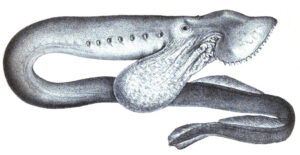
Geotria australis. From: Gray, J. E. 1851. List of the specimens of fish in the collection of the British Museum. Part I. Chondropterygii. London. i-x + 1-160, Pls. 1-2.
25 November
Geotria australis Gray 1851
In 1851, British zoologist John Edward Gray (1800-1875) described and named a peculiar-looking lamprey from Adelaide, South Australia. He called it the Pouched Lamprey because of the “extraordinary development” of a “very large dilatable pouch” hanging from its throat. He called the genus Geotria but did not explain the meaning behind this name, leaving it to us to make an “educated guess” as to his intent. Recently, we came across an explanation of the name that is substantially different from our own. So we took another, closer look. Our conclusion? That we know less about the name than we did before.
Our “educated guess” process usually entails two steps: (1) correctly translating the meaning of the word by tracing its Latin or Greek etymological origin, and (2) applying this meaning to a character or attribute that was mentioned in the original description or, failing that, at least a character or attribute generally known about the taxon at the time. And so, following that process, we drafted and posted the following explanation:
Geotria Gray 1851 — etymology not explained, perhaps from the Greek geotragia, “eating of earth-like substances,” referring to how this lamprey, like other lampreys, uses its suctorial mouth to attach itself to submerged rocks and stones, thus creating the impression that it is feeding on the earth
Our source for the translation of Geotria was the Wiktionary entry for that word, which said it was from the Greek γεωτραγία, or geōtragía, “eating of earth-like substances.” The entry also said, “Like other lampreys pouched lampreys carry stones to a nesting site.” Since Gray did not mention nest-building behavior in his description, we emended the Wiktionary explanation to reflect a lamprey behavior that surely was known to Gray: the use of their suctorial mouths to cling to rocks and even climb small waterfalls and other barriers in freshwater streams. This interpretation fits nicely with the very meaning of the word “lamprey,” derived from lampetra (“rock licker”), and the type genus of the family, Petromyzon, which means “stone sucker.”
A few months ago, while researching the name of an unrelated Australian fish, we came across a paper by bryologist and science writer David Meagher entitled “An etymology of the names of Victorian native freshwater fish,” in the June 2010 issue of Victorian Naturalist. Meagher’s explanation of Geotria surprised us: “presumably from geo– (earth) + Latin atrium (room), alluding to the discovery of the type species G. australis in underground chambers, in which it survives dry periods.”
What? The Pouched Lamprey lives underground? It aestivates like African lungfishes? How did we miss this in Gray’s description?
We quickly returned to Gray’s 1851 text. Gray said nothing about underground chambers (nor did he in a more detailed description of the lamprey in 1853). But we did see a sentence that we had initially overlooked or dismissed as irrelevant: “This development of the pouch, is perhaps to adapt the animal to the long drought of the Australian rivers.”
Meagher apparently connected Gray’s speculation about the pouch to his translation of Geotria: geo– (earth) + Latin atrium (room), thus creating, in our assessment, an erroneous explanation for the name. And, it should be noted, we have found nothing in the literature to substantiate Gray’s suggestion that the lamprey’s pouch helps it survive droughts nor Meagher’s claim that it sequesters in underground chambers (although lamprey ammocoetes live in mud burrows). In fact, G. australis, like other river lampreys, is anadromous. Born in freshwater, it migrates to the ocean where it feeds and matures, and then returns to fresh water to spawn and eventually die.
Although we easily dismissed Meagher’s explanation of the name, we could not dismiss his etymological breakdown of geo + atrium. And so we asked our friend Holger Funk to weigh in on the matter. Dr. Funk is a scholar of Greek and Latin who is researching the emergence of modern ichthyology in the 16th century and currently translating Hippolito Salviani’s Aquatilium Animalium Historiae (1558) into German. He said the Wiktionary translation of geōtragía, “eating of earth-like substances,” was inaccurate. The problem is the phrase “earth-like.” This adjective does not mean “earthy,” as in rocks and minerals, but instead means “products of the earth,” such as grains and vegetables. (Geotria australis, like other parasitic lampreys, is definitely not a vegan!) And even if Gray had based the Pouched Lamprey’s name on geōtragía, Funk asked, why shorten it to the etymogically vague Geotria?
Dr. Funk did find value in Meagher’s geo + atrium etymology, but he suggested that “atrium,” instead of “room,” might mean “house” and by extension “nest,” thus supporting the Wiktionary claim that Geotria refers to the lamprey carrying stones to a nesting site.
All this is well and good except for the fact that nest-building among G. australis has never observed, or at least recorded in the scientific literature. In fact, the first and only in situ observations of the lamprey’s spawning behavior did not occur until 2014-2015, reported by Baker et al. in 2017. According to this paper, G. australis spawns under submerged boulders, with the eggs forming a coagulated cluster adhered to the underside of the boulder. Their observations strongly suggest that while G. australis does indeed use a nest, it does not build a nest from stones and pebbles like their lamprey counterparts in the North Hemisphere.
Baker et al. also provide the first viable explanation for the lamprey’s pouch, termed a gular pouch, which only adult males possess. According to their observations, the male uses his pouch to “groom” the eggs and “vigorously” rub against them while they are hatching, perhaps to ventilate them, increase oxygenation, and remove metabolic wastes.
So what does Geotria mean? We don’t know. The best we can do is summarize the possibilities and address their flaws.
A final question: There are plenty of Greek and Latin words that mean pouch and bag. Why didn’t Gray select one and name the lamprey after its most conspicuous and “extraordinary” (his word) feature? If he had, that would have saved us a lot of etymological trouble.
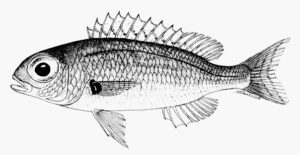
Parascolopsis qantasi. From: Russell, B.C., 1990. FAO Species Catalogue. Vol. 12. Nemipterid fishes of the world. (Threadfin breams, whiptail breams, monocle breams, dwarf monocle breams, and coral breams). Family Nemipteridae. An annotated and illustrated catalogue of nemipterid species known to date. FAO Fish. Synop. 125(12):149p. Rome: FAO.
18 November
Parascolopsis qantasi Russell & Gloerfelt-Tarp 1984
This past Monday, 16 November, was the 100th anniversary of Qantas Airways Limited. And, we’re pretty darned sure, it’s the only airline with a fish named after it.
Qantas was founded in Winton, Queensland, Australia, as Queensland and Northern Territory Aerial Services (hence the acronym Qantas). Its founders believed that the then-fledgling business of air travel might be the way to connect various far-flung outposts in the rural regions of Australia. Its first aircraft was a pre-World War I biplane that could seat a pilot and one passenger. Since then, Qantas has grown to become the largest airline in Australia and, with its kangaroo livery, one of the most recognizable brands in the world.
The fish named after Qantas is Parascolopsis qantasi, a threadfin bream — the Slender Dwarf Monocle Bream (family Nemipteridae) — from the eastern Indian Ocean of Indonesia. According to the etymology section of their description, the authors honored the airline for “invaluable assistance over three years given to the junior author by staff of the Denpasar (Bali) office of the Australian airline Qantas.”
Here’s how the name came about, as told by the junior author, Thomas Gloerfelt-Tarp, to the authors of the upcoming Eponym Dictionary of Fishes:
We were working (1979-1984) on a fisheries bottom trawl survey stretching across Southern Indonesia. This was conducted by the Food & Agriculture Organisation of the United Nations and the German Technical Assistance, plus CSIRO and covered the North West Shelf of Australia. Every day we discovered many undescribed fish. With limited interest from the Indonesian museums, Australia put their hands up to take these fish to complement their own museum collections. We got these fish to Australia by preserving them in formaldehyde, then wrapping them up and putting them in drums and asking Qantas — flying from Bali to various destinations in Australia — if they would freight them on board. Qantas gladly assisted and they did this for free. They would pick them up and fly them to all the museums around the country whose staff gratefully accepted them. 84 new species were found and we thought why not say thank you to Qantas and name a fish after them. It was named with little fanfare. There were some grumblings in the scientific fraternity — “you can’t name a fish after Qantas” — but I said, ‘Well, give it back then!’ But they did not want to relinquish a new species.
While big plans for the airline’s centennial were scaled back due to the pandemic, Qantas did operate a scenic flight over Sydney Harbor to celebrate the big day.
(Our thanks to Bo Boelens and the late Mike Watkins for sharing their Eponym Dictionary of Fishes manuscript.)
11 November
Feroxodon Su, Hardy & Tyler 1986
Learning about this fish’s name made us say “OUCH!”
Feroxodon is a monotypic genus of pufferfishes known from shallow inshore waters along the northern half of Australia. Its name is a combination of ferox, ferocious and odon, tooth, referring to its “fierce” biting habits. As if being too poisonous to eat isn’t enough, this puffer has also been implicated in several unprovoked attacks on human toes.
Two such attacks occurred in 1979 near Proserpine, Queensland, Australia. In one of them, a girl lost three of her toes. In 2012, a five-year-old boy from Queensland required two operations, three stitches, and two weeks in the hospital after a F. multistriatus mauled his feet. The ball of his left big toe was missing and a chunk of flesh was missing from his right heel.
A newspaper account of the incident described the puffer as a “cross between a tadpole and a Great White Shark.”
According to the authors of the name, “Such opportunistic ‘feeding’ behaviour in tetraodontids is indicative of a sometimes highly aggressive predatory nature, which can be likened to a feeding frenzy.”
Like most puffers, F. multistriatus has incredibly strong jaws, which it uses for crushing clams and crustaceans. And the occasional human toe.
 4 November
4 November
Lagocephalus sceleratus (Gmelin [ex Forster] 1798)
Pufferfishes are infamous for the toxicity of many species. Their skin and internal organs contain a neurotoxin produced by symbiotic bacteria. When ingested, this neurotoxin can cause a variety of unpleasant and often fatal symptoms. Perhaps the most frightening of these symptom is paralysis, in which victims may be fully lucid in the 4-6 hours before their death. Japanese scientists tested puffer toxins on humans during the notorious Unit 731 program of World War II.
Only one pufferfish (at least among currently valid taxa) has been named for its toxicity. That’s the Silvercheeked Toadfish Lagocephalus sceleratus of the Red Sea, Indo-West Pacific, and a recent invader of the Mediterranean via the Suez Canal (see the warning poster, shown here). The species was formally named by Johann Friedrich Gmelin (1748-1804), who based his brief description on two accounts — a 1777 memoir written by Johann Georg Forster (1754-1794), and an unpublished scientific manuscript written by Georg’s father, Johann Reinhold Forster (1729-1798). Both were naturalists aboard the HMS Resolution (1772-1775) during Captain Cook’s second voyage around the world.
According to the younger Forster, the captain’s clerk purchased a pufferfish from a native at New Caledonia, in the South Pacific, on 4 September 1774. Forster warned Cook that puffers can be poisonous, but Cook said he had eaten puffers before and experienced no ill effects. There wasn’t time to prepare the entire fish, so Cook, and both Forsters nibbled at the liver. By three o’clock in the morning, all three men complained of numbness and shortness of breath. Forster recorded in his notebook that he could not distinguish between the weights of a feather and a quart pot. He felt better in the morning, but by noon was “suddenly seized with sickness” once again. Unable to stand or walk longer than five minutes, he returned to bed and was sick for another two days. All three men survived their ordeal, probably because they ate so little of the fish.
Captain Cook recalled, “When the natives came on board and saw the fish hanging up, they immediately gave us to understand it was not wholesome food, and expressed the utmost abhorrence of it; though no one was observed to do this when the fish was to be sold, or even after it was purchased.”
Someone fed the remains of the puffer to several dogs and a small pig, which all became sick. The dogs survived. The pig died soon afterwards, “being swelled to an unusual size.”
Gmelin named the fish “sceleratus,” noting that it was extremely poisonous when eaten (“comestus veneni vires edens”). Gmelin apparently borrowed the name from the elder Forster’s unpublished manuscript name “sceleratum.” (The manuscript was eventually published, posthumously, in 1844.)
Dictionaries provide multiple translations for “sceleratus.” Accursed. Criminal. Wicked. Villainous. Infamous. Polluted. Heinous. Harmful. Noxious.
All seem to apply.
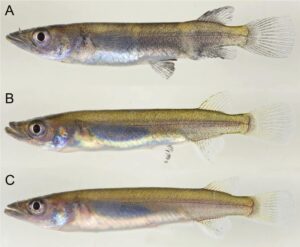
Nomorhamphus aenigma immediately after fixation. (A) holotype, male; (B and C), paratypes, female. From: Kobayashi, H., K. W. A. Masengi and K. Yamahira. 2020. A new “beakless” halfbeak of the genus Nomorhamphus from Sulawesi (Teleostei: Zenarchopteridae). Copeia v. 108 (no. 3): 522-531.
28 October
Nomorhamphus aenigma Kobayashi, Masengi & Yamahira 2020
The specific name of this viviparous halfbeak is a riddle. Literally.
Recently described is the latest issue of Copeia (108, no. 3), N. aenigma occurs in the Cerekang River of Sulawesi Selatan, Indonesia. Unlike other halfbeaks — so named because of the prolonged lower jaw, creating the appearance that the fish has only “half a beak” — N. aenigma is conspicuously “beakless” throughout its entire life. (Some halfbeaks possess the “beak” as juveniles and lose it as they mature.) The name “aenigma,” from the ancient Greek noun for ‘‘riddle,” refers to the riddle raised by this species:
‘‘Why are the mandibles of most halfbeaks long?’’
The authors present an interesting hypothesis. Most halfbeaks swim at water’s surface, where neuromasts on their extended lower jaws may help them locate prey, particularly terrestrial insects that fall into the water. N. aenigma occurs with one such species, N. rex. But unlike N. rex, which swims at the surface, N. aenigma prefers the middle and lower reaches of the stream. The authors posit that N. rex may have evolved short jaws as “ecological character displacement,” the phenomenon wherein two similar or closely-related species that live in the same environment have evolved different traits in order not to compete with each other.
The authors conclude their paper: “To test this hypothesis, detailed comparisons of feeding habits between these two sympatric species [aenigma and rex] are necessary in the future.”
A few words on the meaning of the generic name Nomorhamphus: Proposed by Weber & de Beaufort in 1922, “rhamphus” clearly means beak. The meaning of “nomos” is not so obvious. We suspect it’s from the Greek word for law, custom or tradition. If so, the name may refer to how the lower jaws of this genus do not extend as far as those of other halfbeaks (e.g., Dermogenys) and therefore represent a more “traditional” kind of jaw.
21 October
Fishes from Middle Earth
J. R. R. Tolkien’s Middle Earth legendarium has been a source of fish names since at least 1973. That’s when shark taxonomist Leonard Compagno named the pseudotriakid genus Gollum, remarking how G. attenuatus resembles the “Lord of the Rings” antihero in form and habit.
Other Middle Earth-inspired fish names include:
- The Gollum Galaxias of New Zealand, Galaxias gollumoides McDowall & Chadderton 1999, which, like Gollum, is a “dark little fellow with big round eyes who sometimes frequents a swamp”
- Two driftwood catfish (Auchenipteridae) genera proposed by Steven Grant in 2015: Duringlanis, named after Durin the Deathless, eldest of the Seven Fathers of the Dwarves, referring to the small size of its included species, and Balroglanis, named after the Balrogs, referring to their larger size compared to Duringlanis and the “horns” of their nuchal shield (glanis = general term for catfish)
- A horseface loach, Acantopsis bruinen Boyd, Nam, Phanara & Page 2018, from Cambodia, Thailand and Laos, named for the River Bruinen, or Loudwater, of Rivendell and the flood that took the form of great horses in “The Fellowship of the Ring,” alluding to the common name “horseface loach” for the genus
- A tetra, Astyanax lorien Zanata, Burger & Camelier 2018, whose name is from the Quenya language meaning “Dream Land,” referring to “beautiful” areas on the Chapada Diamantina (Bahia, Brazil) inhabited by this species (Quenya is a fictional language devised by Tolkien, spoken by the Elves)
- The troglophilic Gollum Snakehead of India, Aenigmachanna gollum Britz, Anoop, Dahanukar & Raghavan 2019, which, like Gollum, is a “creature that went underground and during its subterranean life changed its morphological features”
And now, in just the past few months, two more fishes from Middle Earth have been described:
Aspidoras azaghal Tencatt, Muriel-Cunha, Zuanon, Ferreira & Britto 2020 is a callichthyid catfish named for Azaghâl, king of the Broadbeam Dwarves, referring to Terra do Meio (Pará, Brazil, type locality), freely translated as “Middle Earth” in English, and to the fact that this catfish occurs in a mountainous region and reaches a relatively small size, both of which are typical features of Tolkien’s fictional dwarves.*
Pseudophallus galadrielae Dallevo-Gomes, Mattox & Toledo-Piza 2020, a freshwater pipefish from Guatemala, is named for Galadriel (shown here in her cinematic incarnation), the elf ruler of Lothlórien and bearer of the ring Nenya (also known as the ring of water), referring to its additional bony rings (41-55) compared to P. brasiliensis (40-50) and, like all other species of the genus, its occurrence in fresh water.
For an interesting look at the presumed actual fishes of Middle Earth, ichthyologist Philip W. Willink of the Field Museum in Chicago has prepared a handy field guide.
* Although not from Middle Earth, the name of the related Brazilian catfish Aspidoras psammatides Britto, Lima & Santos 2005 derives from Tolkien: it was named after Psamathos Psamathides, the sand sorcerer, from Tolkien’s Roverandom (written in 1925, published in 1998), from psammos, sand, and ides, son of, referring to its sand-dwelling behavior.

The deepwater boxfish now known as Aracana aurita as it appeared in Gray, J. E. 1833 .Illustrations of Indian zoology; chiefly selected from the collection of Major-General Hardwicke, F.R.S. 20 parts [1830-1835] in 2 vols. Pls. 1-202.
Aracana Gray 1833
Aracana is a peculiar name. Peculiar in that Gray spelled it three different ways. Peculiar in that while the name dates to 1833, its spelling dates to 1838. And peculiar in that no one knows what the name means. We present our best guess below.
Aracana is the type genus of Aracanidae, the deepwater boxfishes, comprising six genera with 13 species occurring in the Indo-West Pacific from Hawaii to South Africa, with peak abundance around Australia. They’re related to the boxfishes (Ostraciidae), famous for the square or box-like body shape of many species. But aracanids are considered to be a more primitive form, less boxy in shape, and occurring in deeper waters, usually over 200 m.
British zoologist John Edward Gray (1800-1875) proposed the genus in 1833. “Proposed” may be too generous a word. “Captioned” is more accurate. The name of the genus first appeared as a subgenus of Ostracion (the original boxfish genus) in a series of color plates issued in folio installments from 1830 to 1835 under the collective title “Illustrations of Indian zoology; chiefly selected from the collection of Major-General Hardwicke, F.R.S.” Maj.-Gen. Hardwicke was Thomas Hardwicke (1755-1835), an English soldier and naturalist who collected animals in India under the auspices of East India Company and had them painted in watercolor by Indian artists (all anonymous except for one). He also acquired specimens from other parts of the world and had his Indian artists paint them as well. Gray arranged the paintings for publication and provided names for the species that appeared to be new. There was no descriptive text. Just name and painting.
Here’s where things begin to get peculiar. For the painting of the Australian boxfish Ostracion auritus Shaw 1798, for which Gray proposed a new subgenus, two spellings appear: “Acarana” on the plate itself (shown here), issued in 1833, and “Acerana” on the legend (table of contents) page in the subsequent 1835 folio edition. Note that both spellings differ from “Aracana,” the spelling currently in use. That spelling dates to Gray’s 1838 account of four species he assigned to the subgenus Aracana. Gray did not explain the meaning of the name, nor did he mention the earlier two spellings.
Today, Gray’s 1838 spelling is in use, yet it’s dated to the original 1833 publication of the painting. Or, to put it another way, the name “Aracana” dates to 1833 even though it did not appear in print until 1838!
Today, there are rules in place to prevent such nomenclatural anomalies from occurring. Back then, however, things were more flexible and forgiving. For example, it was okay to propose a name without a written description, and to retain the original authorship of that name when a description was added later. In fact, many zoological nomina, including those of several fishes, date to the names Gray assigned to Hardwicke’s commissions. Whoever first proposed the “Aracana Gray 1833” combination was clearly acknowledging the primacy of Gray’s publication.
But this very same taxonomist — the “first reviser” — also had a choice to make: Which of Gray’s three spellings — Acerana, Acarana or Aracana — should be retained? Two of them are probably misspellings or typos. But which two? By today’s rules, one of the original two spellings would be preferred, ideally “Acarana” because it appeared three years before the “Acerana” spelling in the legend. Ultimately, “Aracana” was selected, probably because it was the spelling Gray used when he formally proposed the subgenus in a descriptive account, and because he mentioned it five times, evidence that it is not a one-time misspelling or typo.
So, what does “Aracana” mean? As far as we know, only one reference has attempted an explanation, the online Monaco Nature Encyclopedia. The author considered Aracana, a city in the landlocked country of Bolivia, and Akarana, the Maori name for Auckland, New Zealand, but wisely dismissed them both.
Although Gray did not explain the etymology of the subgenus (now full genus) Aracana, he provided a clue in his 1838 account. He called these boxfishes “parrot fishes,” perhaps because of their “beautiful” colors and/or their fused teeth, which form beak-like plates, giving them a parrot-like facial appearance. Based on the “parrot fish” name, we suggest that Aracana relates to the Scarlet Macaw, Ara macao, which in Gray’s day also went by the name Aracanga, Macrocercus aracanga.
The similarity between “Aracana” and “Aracanga” is too close to dismiss.

Ken Lazara with this 2002 Killifish Hobbyist of the Year award from the American Killifsh Association.
7 October
In memoriam: Kenneth J. Lazara
Yesterday I learned that Ken Lazara passed away on 27 August at the age of 81. Ken was the “junior” author of The ETYFish Project.
I began work on The ETYFish Project in 2009. For the first five years I collaborated with Ken, who provided much of the mundane but necessary library work during his tenure as a Research Associate at the American Museum of Natural History in New York City. Every week or so I sent Ken a list of original descriptions I did not own or could not find online. He would then visit the Museum’s library, scan the papers, and email them to me. He also helped translate some of the non-English texts, or found colleagues at the Museum to translate them for me. He served in this capacity for five years. I added his name as co-author when The ETYFish Project went online in 2013.
Ken and I first met each other online when I was researching and writing the five-part “Annotated Checklist of North American Freshwater Fishes” for the North American Native Fishes Association (2005-2009). He particularly enjoyed the etymology sections I included, and helped me track down the meanings of some of the more enigmatic names. When I told him about my idea of researching the etymologies of all fish species, he immediately volunteered his library and research services.
I met Ken in person only once. It was during the early years of the Project, and even then I could see that he was frail. Amazingly, despite his declining health, he somehow managed to visit the Museum in Manhattan from his Brooklyn home and continue to scan papers for me. Eventually his visits became less frequent until they ceased altogether. He never told me why but I knew.
Ken remained a steady correspondent over email. I sought his counsel on difficult names and some of the more speculative explanations I was proposing. But then he stopped replying. I called him and left messages. He never returned the calls. I suspected his health had taken a serious turn for the worse. Through a contact at the American Killifish Association I learned that it had.
Before he retired, Ken was a physics professor at the United States Merchant Marine Academy in Kings Point, New York. During his spare time, and during the early years of his retirement, he was a celebrated and influential killifish hobbyist with a keen interest in taxonomic minutiae. He contributed several important articles on killifish taxonomy to the journal Copeia and described three new killifish species — Maratecoara lacortei, Spectrolebias costai and Plesiolebias aruana — in 1991. He collaborated on the description of Aphaniops stiassnyae in 2001, the same year he released his magnum opus, The Killifishes: An Annotated Checklist, Synonymy, and Bibliography of Recent Oviparous Cyprinodontiform Fishes, also known as The Killifish Master Index (4th edition).
I miss Ken’s superb bibliographical detective work, his sharp editorial eye, and his passion for nomenclatural arcana.
I wish we had begun our collaboration 10 years earlier.
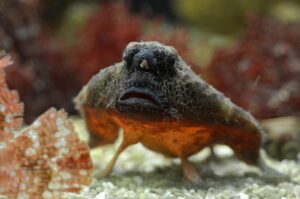
Short-nosed form of the Shortnose Batfish, Ogcocephalus nasutus. Photo by Gilles San Martin. Courtesy: Wikipedia.
30 September
Ogcocephalus nasutus (Cuvier 1829)
Here’s an amusing case of a fish’s common name meaning the exact opposite of its scientific name.
Ogcocephalus nasutus is a batfish that occurs in the Western Atlantic from southern Florida to eastern Venezuela. It’s named nasutus, meaning long-nosed, large-nosed or big-nosed, referring to the well-developed horn protruding from its rostrum.
Yet the English common name for this fish is Shortnose Batfish!
Here’s our explanation for the discrepancy.
All Ogcocephalus have long rostra. Ogcocephalus nasutus was the second named species in the genus (there are now 12 validly recognized species). So its large rostral process was indeed a clearly visible physical attribute worthy to be referenced in its name. But as more species began to be described in the genus, its big nose simply wasn’t as big as some of its congeners. And as more specimens of O. nasutus were collected, cataloged and measured, taxonomists discovered that its rostral length is quite variable. Sometimes it’s long, looking almost finger-like, and sometimes it’s short, ranging from a knob to a thick cone in appearance.
We’re not sure when “Shortnose Batfish” first appeared in the literature, but whoever coined it was probably comparing the length of this batfish’s rostral process to that of its congeners, particularly the Longnose Batfish, Ogcocephalus corniger. This species, described by batfish expert Margaret Bradbury in 1980, also occurs in the Western Atlantic but north and west of O. nasutus, from North Carolina to Florida, and along the northeastern Gulf of Mexico to Louisiana. Bradbury named it “corniger,” meaning horn-bearer, for its long, upturned rostrum. In fact, Bradbury noted that its long rostrum separates it from all other species of Ogcocephalus except O. vespertilio, O. pumilus, and “long-nosed morphs” of O. nasutus.
In other words, the “long-nosed” Ogcocephalus is called the Shortnose Batfish because its nose, although long, is usually not as long as others in its genus.
Like other members of the anglerfish order Lophiiformes, batfishes possess an angling apparatus — the illicium (rod) and esca (bait) — by which they attract prey. On Ogcocephalus species, this apparatus is attached to a cavity just beneath the rostrum. We’re sure Ogcocephalus nasutus would agree it’s not the rostrum’s size, but rather its performance, that matters.
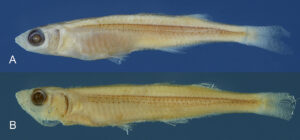
(A) Membras pygmaea, (B) Membras procera. From: Chernoff et al. 2020. Two new miniature silverside fishes of the genus Membras Bonaparte (Atheriniformes, Atherinopsidae) from the Tropical North Atlantic Ocean. Zootaxa 4852 (2): 191–202.
23 September
Two silversides, 12 authors
How many people does it take to describe a new species of fish?
12, apparently:
Membras procera Chernoff, Machado-Allison, Escobedo, Freiburger, Henderson, Hennessy, Kohn, Neri, Parikh, Scobell, Silverstone & Young 2020
Membras pygmaea Chernoff, Machado-Allison, Escobedo, Freiburger, Henderson, Hennessy, Kohn, Neri, Parikh, Scobell, Silverstone & Young 2020
These two species of miniature silversides (Atherinopsidae) were recently described from coastal habitats in the tropical North Atlantic. Membras procera, from the Gulf of Urabá, Colombia, is named for its overall shape (procera = long or slender), reaching just 36.3 mm SL. Membras pygmaea, from Brus Lagoon, Honduras, is named for its diminutive size, <41 mm SL.
We believe 12 is the record for the highest number of authors of a fish name, breaking the record previously set by the neotropical cichlid Apistogramma allpahuayo, proposed by 11 authors — Römer, Beninde, Duponchelle, Díaz, Ortega, Hahn, Soares, Díaz Cachay, García Dávila, Cornejo & Renno — in 2012.
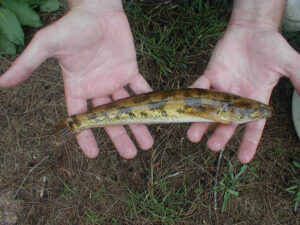
Pseudaphritis urvillii. Photo by Peter J. Unmack.
16 September
Pseudaphritis urvillii (Valenciennes 1832)
The Congolli, Pseudaphritis urvillii (Valenciennes 1832), is the sole member of the family Pseudaphritidae. It’s a catadromous fish from coastal rivers of southern Australia and Tasmania, living in fresh water as adults and moving downstream to estuaries to spawn. There’s a lot packed into its generic and specific names.
The genus Pseudaphritis was proposed by François Louis Nompar de Caumont La Force, comte de (count of) Castelnau (1810-1880), a French naturalist who published several papers on Australian fishes in the 1870s, including this one in 1872. The first part of the name is formed with the prefix pseudo-, meaning “false,” often used by taxonomists to connote how one taxon may resemble another and may falsely be mistaken for it. In this case, Pseudaphritis is named for its resemblance to Aphritis, “but the scales are rather large, the first dorsal has seven rays, and just in front of the anal there is a short fin composed of two spines.”
The name Aphritis, at least in fishes, is no longer in use. The great French naturalist Achilles Valenciennes proposed it for what is now Pseudaphritis urvillii in 1832, but did not realize that it had already been in use for a genus of flies, Aphritis, proposed by French zoologist Pierre André Latreille in 1805. (Latreille was equally silent on why he selected that name.) The name was replaced by the Baltic zoologist Friedrich Wilhelm Karl (“Carlos”) Berg (1843-1902), who renamed it Phricus in 1895. Eventually, ichthyologists determined that Phricus and Pseudaphritis were the same genus, in which case the name would default to the earliest available name. Since Aphritis was unavailable, that honor fell to Pseudaphritis. And so, opposite of what the name means, the “false Aphritis” is actually an Aphritis!
Valenciennes did not explain why he selected the name Aphritis nor what the word means. The name dates to Aristotle, who described it as a kind of anchovy or whitebait. The Greco-Egyptian author Athenaeus (late 2nd to early 3rd centuries AD) said it was not produced from roe, as Aristotle had written, but from a foam that floats upon the surface of the water and collects in quantities after heavy rains. Indeed, aphritis is derived from aphros, meaning “foam.” There is, of course, nothing anchovy-like about P. urvillii, but Aristotle used the term as a catch-all for any small fish that’s edible when boiled. It’s possible that Valenciennes, as did his predecessor and mentor Georges Cuvier, simply repurposed a fish name used by the ancients with no apparent taxonomic relevance.
Fortunately, the specific name is not a mystery. Valenciennes named it in honor of Jules Sébastien César Dumont d’Urville (1790-1842), who led the expedition during which the type was collected. Dumont d’Urville was a French naval officer who spoke Latin, Greek, English, German, Italian, Russian, Chinese, and Hebrew in addition to his native French. Apparently his knack for languages helped him pick up some of the lesser-known and more exotics languages of the South Pacific. In addition to picking up languages, Dumont d’Urville also acquired a large collection of plant and animal specimens that kept Cuvier, Valenciennes and others quite busy. A number of plants are named after him, as is the Australian longtom or needlefish Strongylura urvillii. The Adélie Penguin Pygoscelis adeliae was named after his wife Adélie.

1842 illustration of the Versailles train derailment and fire that killed Jules Sébastien César Dumont d’Urville, his wife and son, and over 50 others.
For all his years at sea, it was travel on land that claimed Dumont d’Urville’s life. On 8 May 1842, he and his wife and only son boarded a train from Versailles to Paris. Moving at a high rate of speed, the first of its two locomotives snapped an axle and came to a dead stop. The second locomotive was then driven by its momentum on top of the first, scattering the contents of both fire boxes among the debris. Three carriages crowded with passengers were then piled on top of this burning mass and crushed into each other. The carriages were newly painted and blazed up like kindling. Dumont and his family — along with 50 or so other people — perished in the flames.
 9 September
9 September
Etheostoma faulkneri, the Yoknapatawpha Darter
Here’s a rare case of a fish’s common name being longer and harder to pronounce than its specific epithet.
Etheostoma faulkneri was recently described (31 August) as a new species of darter (Percidae) from the Little Tallahatchie and Yocona river watersheds of north-central Mississippi (USA). The authors — Ken A. Sterling and Melvin L. Warren, Jr. — named it for the Nobel Prize-winning American writer William Faulkner (1897-1962). Faulkner’s 1929 novel The Sound and the Fury ranks #6 on the Modern Library’s list of the 100 best English-language novels.

Etheostoma faulkneri, male holotype. From: Sterling KA, Warren, Jr. ML. 2020. Description of a new species of cryptic snubnose darter (Percidae: Etheostomatinae) endemic to north-central Mississippi. PeerJ 8:e9807
Faulkner was a native of the Oxford, Mississippi, the area where the darter occurs. “The landscape was an important theme in many of his works,” Sterling and Warren wrote, “and the actions of his characters were often influenced by the lands and streams surrounding his fictional Jefferson, Mississippi, including the Yocona River, which he renamed the Yoknapatawpha.”
“Yoknapatawpha” is the original name of the Yocona River. It is derived from two words from the language of the area’s indigenous Chickasaw people: Yocona and petopha, meaning “split land.” Faulkner himself said the name means “water flows slow through flat land.” Many of his novels took place in this imaginary county, as did his 1930 short story “A Rose for Emily,” a staple of many American high-school literature classes.
While we’re all for fishes being named after famous writers and incorporating local or indigenous names, we can’t imagine too many people outside Yocona County, Mississippi, commonly calling this fish the “Yoknapatawpha Darter.”
Speaking of darters named after famous Americans, here’s a pun that at least country-music fans should get right away. What if a darter species was named after singer-songwriter Loretta Lynn? Its common name would be “Coal Miner’s Darter.”

Oneirodes eschrichtii. From: Lütken, D. F. 1871. Oneirodes eschrichtii Ltk. en ny gronlandsk Tudsefisk. Oversigt over det Kongl. Danske Vidensk. Selsk. Forhandl Kjobenhavn 1871 (2): 56-74+ 9-17, Pl. 2.
2 September
Oneirodes Lütken 1871
Deep-sea anglerfishes (ceratioids) are arguably the most bizarre and malevolent-looking fishes in the world. That’s why many have the demonic common name “seadevil.” But one family of deep-sea anglers has a peaceful, illusory, even ethereal-sounding name. Dreamers. And like most things in a dream, the name makes sense — and doesn’t make sense —at the same time.
In 1845, Carl Peter Holbøll (1795-1856), an officer in the Danish Royal Navy and amateur naturalist, obtained a fish from the deep waters off Greenland. He sent it to physiology and anatomy professor Daniel Frederick Eschricht (1798-1863) at the University of Copenhagen, where it sat on a shelf, unnoticed, for 25 years. Danish professor Christian Frederick Lütken (1827-1901) found the specimen and realized it was different from the three other genera of deep-sea anglers known at the time. Lütken wrote a lengthy and detailed description of the specimen, which appeared in three languages, Danish, French and English. He named the fish Oneirodes eschrichtii, after the man who shelved it and forgot about it. In a footnote Lütken said the generic name means “dream-like” (óneiros, dream, and eîdos, form or likeness). He did not explain why he selected that name. We combed through all three versions of the description looking for clues, finding none.
Over the decades, ichthyologists have attempted to interpret the name, confidently, not letting on that they’re just guessing. In 1898, Jordan & Evermann, in Fishes of North and Middle America (volume 3), say the name refers to its small eyes almost covered by skin, presumably alluding to how the fish swims with its eyes closed, as if asleep, perhaps dreaming of its next meal what with food being scarce in the vast and desolate abyss.
In 1968, in their fine little book Deep-water Fishes of California, Fitch & Lavenberg say the name means “something out of a dream, in reference to its almost unbelievable shape.”
A third explanation comes from Theodore W. Pietsch, the world authority on deep-sea anglers. In his 2009 magnum opus Oceanic Anglerfishes: Extraordinary Diversity in the Deep Sea, Dr. Pietsch said Oneirodes is “perhaps the most appropriate of the many early names assigned to deep-sea anglerfishes,” implying that O. eschrichtii is “so strange and marvelous that it could only be imagined in the dark of the night during a state of unconsciousness.”
At some point, Oneirodes was given the common name “dreamer,” evoking “dream-like” and “out of a dream” (as humans perceive the fish), but oddly turning the adjective into a noun, i.e., one who dreams. We’re not sure when this happened. The earliest mention we’ve found is the Fitch & Lavenberg book from 1968.
Maybe we’re interpreting Lütken’s “dream-like” the wrong way. Take a look at the illustration that accompanied his description (shown here). That’s one bizarre and scary looking fish! By calling it “dream-like,” was Lütken actually saying it was “nightmarish”? In other words, the fish is not so much fantastical, surreal or weird the way dreams are weird. It’s creepy and monstrous and indeed a devil from the deep.
Theodore Pietsch’s student James Wilder Orr raised this possibility when he named a related species, Oneirodes epithales, in 1991. “Epithales” is Greek for nightmare. Like Christian Frederick Lütken, Dr. Orr did not explain why he selected this name. So we asked him via email. “I always thought it was funny that species of Oneirodes, all of which are black blobs, would be called Dreamers,” he replied. “The picture of a fish drifting along dreamily, lighting the deep-sea world with a little light [bioluminescent esca, the anglerfish’s “bait”] was a nice fancy. But the fact that the little light was attracting innocent prey that were to be engulfed by a massive mouth full of sharp teeth seemed nightmarish. Hence, the name.”
Perhaps Lütken felt the same way about O. eschrichtii in 1871. It’s the stuff of dreams all right. Bad dreams.
Dreams with sharp teeth.

Devario memorialis. From: Sudasinghe, H., R. Pethiyagoda and M. Meegaskumbura. 2020. Evolution of Sri Lanka’s giant danios (Teleostei: Cyprinidae: Devario): teasing apart species in a recent diversification. Molecular Phylogenetics and Evolution v. 149. Article 106853.
26 August
Devario memorialis Sudasinghea, Pethiyagoda & Meegaskumbura 2020
On 14 May 2016, a massive low-pressure system formed over the Bay of Bengal, causing torrential rainfall across Sri Lanka. It strengthened to form Cyclone Roanu. Over the next four days, the rain caused devastating floods and landslides across the eastern and southern parts of the country. According to Wikipedia, 101 people died and 100 are still missing.
On 17 May, a landslide occurred in Samsarakanda near Aranayaka in Kegalle District. It buried several homes, killing 21 people and leaving 123 missing. On this day, a team of biologists were conducting fieldwork near Aranayaka. They collected several fish species in a 3-km stretch of a headwater stream of the Ma Oya (river), at an elevation range of 238–266 m above sea level. The most abundant fish in the area, usually observed in shoals, was a small, colorful cyprinoid related to the popular danios of aquarium fame. It turned out to be a new species, now given the name Devario memorialis. The authors wrote:
“The species is named in memory of those who perished in the disastrous landslide at Aranayake, the type locality, in May 2016, while our fieldwork was in progress.”
The generic name Devario dates to German zoologist Jacob Heckel (1790-1857). He proposed the genus in 1843, establishing (and naming) it for Cyprinus devario Hamilton 1822 of India, Bangladesh, Myanmar and Nepal. “Devario” is a latinization of “Debari,” the local Bengali name for this species.
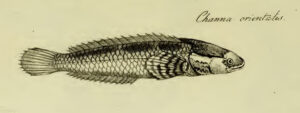
Channa orientalis. From: Bloch, M. E. and J. G. Schneider. 1801. M. E. Blochii, Systema Ichthyologiae Iconibus cx Ilustratum. Post obitum auctoris opus inchoatum absolvit, correxit, interpolavit Jo. Gottlob Schneider, Saxo. Berolini. Sumtibus Auctoris Impressum et Bibliopolio Sanderiano Commissum. i-lx + 1-584, Pls. 1-110.
19 August
Channa Scopoli (ex Gronow) 1777
The snakehead genus Channa represents a group of air-breathing, predatory Asian fishes well-known in aquaria, fish culture, angling, and native medicines, and for the invasive tendencies of some species stocked outside of their native ranges. The meaning of their generic name is not so well-known. In fact, we’re not sure what it means.
The name entered the literature in 1763, in Zoophylacii Gronoviani by Dutch naturalist Laurens Theodorus Gronovius (also known as Gronow, 1730-1777). Gronovius had amassed a large private collection of plant and animals specimens, including a snakehead he had acquired from somewhere in “India Orientali,” i.e., Asia. He called the genus Channa but did not explain why. Since Gronovius did not adopt Linnaeus’ still-young system of binomial nomenclature, his introduction of the name Channa is not considered available for nomenclatural purposes. Italian-Austrian physician-naturalist Giovanni Antonio Scopoli (1723-1788) made the name available in 1777 when he published Gronow’s name in proper Linnaean form. Again, no explanation of what the name means.
Over the decades, scholars have guessed that Channa is derived from either channe or channos, a Greek name for a wide-mouthed fish of the sea. As predators, Channa have large mouths, so the name seems to fit. In addition, Greeks and Romans had called some Mediterranean wrasses Channa, Channus and Canna. So maybe Gronovius borrowed the name, or thought there was something wrasse-like about the snakehead. We’ll likely never know.
A week or so ago, Richard van der Laan, one of the editors of Eschmeyer’s Catalog of Fishes, alerted us to a new paper on the genetic diversity of the Ceylon Snakehead Channa orientalis, now considered the species Gronovius had in his collection. The authors proposed an interesting new explanation for the name.
First, the authors were able to narrow Gronovius’ “India Orientali” down to a more specific type locality — southwestern Sri Lanka. There, they say, the local (Sinhala) name for small snakeheads is kanaya. Since that area was under Dutch rule at the time (which may explain how Gronovius acquired his specimen), the authors posit that Channa — pronounced “kanna” — is a Dutch transliteration of kanaya.
Very interesting indeed. But there are two problems with this explanation. First, the authors do not even consider the possibility that Channa could be derived from the Greek channe or channos. “Unlike most of Gronovius’s generic names,” they wrote, “Channa does not appear to be rooted in Greek or Latin.” Except it does appear to be rooted in Greek!
Problem #2 is more vexing. According to Richard van der Laan, a Dutchman himself, the Dutch pronunciation of Channa is not “kanna.” It’s actually “ganna.”
We’re not saying there is no etymological connection between Channa and kanaya. But we are saying the evidence is weak.

A 1900s greeting card reading “Greetings from Krampus!”
12 August
Protomelas krampus Dierickx & Snoeks 2020
Paedophagia among cichlid fishes of Lake Victoria and Lake Malawi has inspired some interesting names.
The genus Caprichromis Eccles & Trewavas 1989 is based on capra, Latin for goat, for the butting or ramming behavior these fishes use to force mouthbrooding females of other cichlid species to relinquish their broods.
The trivial name of Haplochromis gracilifur Vranken, van Steenberge & Snoeks 2019 means “slender thief,” referring to its slender body and how it steals fry from the mouths of mouthbrooding cichlids.
And Haplochromis cronus Greenwood 1959 is possibly named for Cronus, from Greek mythology, who devoured his sons as soon as they were born. (See the 20 June 2018 “Name of the Week” for the complete story.)
Now there’s Protomelas krampus, a recently described paedophagous cichlid from Lake Malawi. It’s named for Krampus, a demon character in European folklore who puts naughty children in a bag and takes them away, reminiscent of this cichlid’s paedophagous behavior.
The name also connects the goat-like appearance of Krampus with the cichlid’s goat-like butting behavior (similar to that of the genus Caprichromis, mentioned above).
Unlike other paedophages whose behavior has been recorded, P. krampus attacks mouthbrooding females from above. According to Ad Konings, in the second edition of his Malaŵi Cichlids in their Natural Habitat (2016), “Such attacks are sometimes initiated several meters above the victim. … In most observed instances the females were aware of the approaching thief and chased it away. The diagonal position of the mouth may be an adaptation to this hunting technique since, coming from above, it will be in a straight line with the fry when these are expelled.”
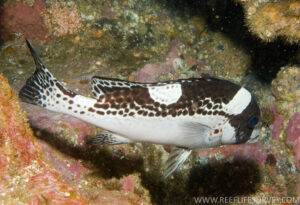
A juvenile Plectorinchus pica, showing its magpie-like coloration. Source: Andrew J. Green / Reef Life Survey.
5 August
Plectorhinchus pica (Cuvier 1828)
It’s a grammatical rule that some taxonomists overlook or apply incorrectly. If a species-group name is an adjective, then it must agree in gender (masculine, feminine, neuter) with the generic name with which it is combined. If a species-group name is a noun, then it does not need to agree in gender with the generic name. This rule (Article 31.2 of the International Code of Zoological Nomenclature) accounts for many minor changes in the spelling of names when a species is reclassified from one genus to a different genus with a different gender. Hypothetically, a fish named for its silvery coloration could be known under three different spellings if it has been placed in different genera over the years, e.g., argenteus (masculine), argentea (feminine) or argenteum (neuter).
As stated above, some taxonomists, perhaps not properly schooled in Latin grammar, overlook this rule. But at other times, taxonomists enforce the rule but do so incorrectly when they confuse an adjective for a noun or vice-versa. (This can be tricky: Does “spilurus” mean spot tail or spot-tailed? The rule of thumb is that the name is always a noun unless the author has indicated otherwise.)
While working on the grunt family Haemulidae, we discovered that a species-level name, long treated as an adjective, is actually a noun. Plectorhinchus pica, the Painted Sweetlips, occurs in coral reefs of the Indian and western Pacific oceans at depths of 3 to 50 m. It occasionally shows up in the aquarium trade. Georges Cuvier named it Diagramma pica, first in a plate (published in 1828), then in a written description two years later. Cuvier did not explain the meaning of the name, but he gave it a French vernacular: “Le Diagramme Pie.”
“Pie” is French for magpie. “Pica” is the Latin equivalent of the word. Indeed, the scientific name of the European Magpie is Pica pica. So “pica” is clearly a noun. Our guess is that the name refers to the black-and-white (i.e., magpie-like) color of juveniles. The rare book in which the plate was published has not been digitized (nor do we own it) so we cannot reproduce it here.
At some point (we don’t know when), Diagramma pica was moved to its current genus, Plectorhinchus. Whoever made the move (we don’t know who), or a subsequent taxonomist, apparently treated “pica” as an adjective and emended the spelling to “picus.” And there the spelling remained for many years until we had a look.
Eschmeyer’s Catalog of Fishes has added a note that the name is a noun and, per our recommendation, has emended the spelling back to Cuvier’s original “pica.” Whether future taxonomists take note and “picus” falls out of use remains to be seen.
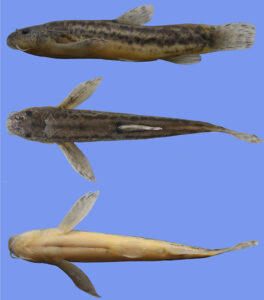
Seminemacheilus dursunavsari, holotype, NUIC-1811, male. From: Çiçek, E. 2020. Seminemacheilus dursunavsari, a new nemacheilid species (Teleostei: Nemacheilidae) from Turkey. Iranian Journal of Ichthyology v. 7 (no. 1): 68-77.
29 July
Seminemacheilus dursunavsari vs. Seminemacheilus tubae
It’s rare for one taxonomist to accuse others of “unethical” behavior in the pages of a scientific journal. But that’s what happened here.
In March 2020, Turkish ichthyologist Erdoğan Çiçek described Seminemacheilus dursunavsari, a new species of nemacheilid loach from Konya province, Turkey, in the Iranian Journal of Ichthyology. He named it in honor of marine biologist Dursun Avşar (Cukurova University, Adana, Turkey), for his support as Çiçek’s supervisor.
Three months later, a team of four taxonomists — Baran Yoğurtçuoğlu, Cüneyt Kaya, Matthias F. Geiger and Jörg Freyhof — declared that S. dursunavsari was improperly described and gave it a new name. Publishing in the journal Zootaxa, Yoğurtçuoğlu et al. said that Çiçek neglected to mention the name of the museum where the name-bearing types of the new species are deposited, as required by Article 16.4.2 of the International Code for Zoological Nomenclature (ICZN).
Let’s repeat the important phrase here, in caps for emphasis: NEGLECTED TO MENTION THE NAME OF THE MUSEUM WHERE THE NAME-BEARING TYPES OF THE NEW SPECIES ARE DEPOSITED.
Although Çiçek designated “NUIC-1811” as the holotype, he did not name the “NUIC” collection beyond its acronym nor describe where the collection is located. For this reason, Yoğurtçuoğlu et al. claim that Seminemacheilus dursunavsari Çiçek 2020 is an invalid name that fails to meet the requirements of the ICZN. So they renamed it Seminemacheilus tubae, in honor of the second author’s’ wife, Tuğba (Tuba) Kaya, for her “endless patience and support with him and his work.”
Çiçek was unhappy about this. He quickly submitted and published a short response and erratum, also published in the Iranian Journal of Ichthyology. He said that none of the authors of the second paper notified him of the error. Instead, they “followed an unethical approach” by renaming the fish without giving Çiçek the opportunity to correct the editorial error.
Çiçek also pointed out that “NUIC” is a known international museum code for the Ichthyology Collections of Nevsehir Haci Bektas Veli University in Nevşehir, Turkey — a fact clearly evident in the author’s mailing address on the title page, and a fact that must be known by the two senior authors of the replacement name, who are also Turkish.
For now, we’re following Eschmeyer’s Catalog of Fishes in recognizing S. dursunavsari over S. tubae. According to ECoF (6 July 2020 edition): “Original description failed to mention explicitly the location where the types are deposited [ICZN Art. 16.4.2], but it was recognizable by indication, and address provided on title page. … We temporarily treat this taxon as valid, but a decision by ICZN may be required.”
Without knowing anything beyond the above-stated facts, we offer the following observations and questions:
1) We’re sticklers for nomenclatural accuracy and proper procedure, but throwing out a name because the author forgot to properly credit a museum seems unnecessarily strict and petty.
2) Contacting Çiçek about the error and giving him the chance to fix it would have been the courteous, professional thing to do — and it would have prevented adding another name to the literature for future taxonomists to deal with.
3) Renaming the fish in honor of a different person seems cold-hearted to us. They easily could have added the museum abbreviation and retained the dursunavsari name even while claiming authorship for themselves.
4) We’re surprised that Rohan Pethiyagoda, who accepted the Yoğurtçuoğlu et al. manuscript for Zootaxa, and other editors and reviewers for that journal, allowed the description of S. tubae to get published. Would other journals have accepted the name?
5) Was there any previous animosity between Çiçek and Yoğurtçuoğlu et al.? We can’t help wonder.
6) We feel sorry for the two individuals for whom the competing nomens honor, Dursun Avşar and Tuğba (Tuba) Kaya. They’re innocent bystanders in this contest for nomenclatural priority, yet it is their names and identities which are at stake. Having a fish named after you must be nice. Having that honor taken away by a technicality will no doubt sting. Knowing that you were given the honor because of said technicality probably doesn’t feel good either.
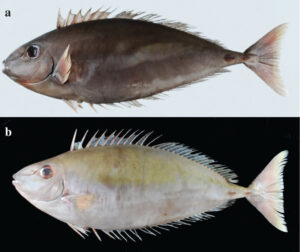
Naso tergus, (a) adult male holotype, (b) adult female paratype. From: Ho, H.-C., K.-N. Shen and C.-W. Chang. 2011. A new species of the unicornfish genus Naso (Teleostei: Acanthuridae) from Taiwan, with comments on its phylogenetic relationship. Raffles Bulletin of Zoology v. 59 (no. 2): 205-211.
22 July
Naso tergus Ho, Shen & Chang 2011
It must be a challenge for some Chinese ichthyologists to coin and correctly form biological nomens when the Latin alphabet is so different from their form of writing. Without at least a working knowledge of Latin and its Romance-language descendants, words derived from Latin and Greek and the syntactical complexities of Latin grammar must seem confoundingly strange. Maybe that’s why so many Chinese fish taxonomists keep it simple and coin locative names with the suffix –ensis: guangxiensis, lancangjiangensis, qiongzhongensis, szechuanensis, and around 380 others.
Here’s a name in which the authors, possibly with an English-Latin dictionary in hand, tried to come up with a descriptive non-locative name. Unfortunately, they picked the wrong Latin word.
Naso tergus is a unicornfish (Acanthuridae) discovered off the coast of Taiwan in 2010. According to the etymology section, “The species name, tergus, meaning ‘to hide’, refers to the typical appearance of this species that makes it resemble subadults of many other Naso species.” In other words, N. tergus so closely resembles some of its congeners that it “hid in plain sight” — at least until some molecularists took a closer look at its ETS2, 16S and Cyt b genetic markers.
It seems the authors did not realize that the Anglo-Saxon “hide” is a homograph — a word that shares the same spelling as another word, and often the same pronunciation, but can have two different meanings. In this case, “hide” can be a verb (to conceal) and a noun (back, skin, leather). However, the Latin equivalents of these meanings of “hide” are different words. The authors selected, “tergus,” which refers specifically to the noun. A better name would have been “tectus,” which means concealed, secret or disguised.
For what it’s worth, both definitions of the Anglo-Saxon “hide” appear to have a common ancestor. Hide, the verb, is from the Old English hydan. The noun (large animal skin) is from another Old English word, hyd. The words are related in that they both connote a “covering.”
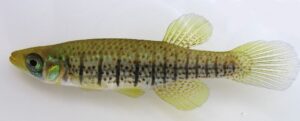
Fundulus nottii © Uland Thomas. Courtesy: North American Native Fishes Association.
15 July
Fundulus nottii (Agassiz 1854)
Two weeks ago, the American Society of Ichthyologists and Herpetologists announced that it was changing the name of its prestigious journal, Copeia, because the scientist for whom it was named, ichthyologist-herpetologist Edward Drinker Cope (1840-1897), held and promoted repugnant racist views.
It was not uncommon for American biologists of the 19th and early 20th centuries to promote white superiority and eugenics under the banner of science. We’ve touched upon the subject in two previous “Name of the Weeks” (26 July 2017, Ctenogobius shufeldti and 3 June 2020, Agonomalus jordani). Here’s another example:
The Bayou Topminnow Fundulus nottii (Agassiz 1854) is a fundulid killifish that occurs in lakes, ponds and slow-moving backwater and overflow pools of rivers in the southeastern United States (Mississippi, Louisiana and Alabama). It was named in honor of Josiah Clark Nott (1804-1873), a medical doctor from Mobile, Alabama, who sent the holotype to Harvard biologist-geologist Louis Agassiz (1807-1873). But fishes were not the only interest Agassiz and Nott had in common. They also shared the belief that African blacks were biologically inferior to European whites.
Agassiz was a proponent of “polygenesis,” a theory of human origins that posits the view that the human races are of different origins. Agassiz gave it a Creationist spin: He believed only white people descended from Adam and Eve and that blacks and whites could be regarded as different species. What’s more, Agassiz admits being repulsed by black people. “In seeing their black faces with their thick lips and grimacing teeth,” he wrote, “their large curved nails, and especially the livid color of their palms, I could not take my eyes off their face in order to tell them to stay far away.”
While Agassiz never supported slavery, Josiah Clark Nott certainly did. Like many white people of the antebellum American south, he owned slaves. Nott once claimed, “the negro achieves his greatest perfection, physical and moral, and also greatest longevity, in a state of slavery.”
While we can remove statues, take down Confederate flags, and change the names of journals, Fundulus nottii will forever honor Josiah Clark Nott. Naming a plant or animal after someone who harbors racist or other offensive views is deemed acceptable as long as the description does not explicitly honor the person for such views.
If we changed F. nottii, then we would need to do the same for the dozens, if not hundreds, of fish names that honor Jordan, Cope, and others with repugnant beliefs by today’s standards. Doing so would create nomenclatural havoc.
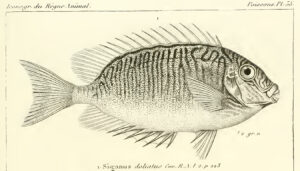 8 July
8 July
Siganus doliatus Guérin-Méneville 1829-34
This rabbitfish from the Indo-West Pacific represents an oddity in ichthyological nomenclature. As far as we know, it’s the only fish taxon whose publication date is unknown.
The name dates to a plate (shown here), back in the pre-ICZN days when an illustration of a plant or animal, as long as it was captioned with a proper binomial, was sufficient to establish a name in the literature. Trouble is, no one knows precisely when this plate was published.
Between 1829 and 1844, French entomologist Félix Édouard Guérin-Méneville (1799-1874) published a series of illustrations as a companion to Le Règne Animal (The Animal Kingdom) by Georges Cuvier, first published in December 1814, reissued in a five-volume second edition (1829-30), and then a third edition updated by Cuvier’s “disciples” (1836-49).
The caption or legend reads: “Siganus doliatus Cuv. R. A. t. 2. p. 233),” referring to page 233 of volume two (1829) of the second edition of Cuvier’s Le Règne Animal. Cuvier listed the names of various siganid species previously described by other authors and mentioned that additional species were to be named in a forthcoming publication (the multi-volume Histoire Naturelles des Poissons). S. doliatus was one of these additional species, whose written description appeared in 1835. Apparently, though, Guérin-Méneville had access to Cuvier’s manuscript names. Since the illustration and its caption predates the written description, Guérin-Méneville is considered the “author” of the name even though Cuvier almost certainly coined it.
Guérin-Méneville issued the plates in a series of installments. Unfortunately, he did not date the plates. Although the plates were numbered, they were not published in sequence. Nor did they follow any taxonomic order. Plates of fishes were interspersed with those of insects, reptiles, molluscs, birds, mammals, and so forth. (Later, after all the installments had been were issued, the plates were republished in larger folios in taxonomic groupings.) There were 70 fish plates in all, originally published between 1829 and 1838.
Most references date Siganus doliatus to 1829-38. As we investigated the name, we found that it was mentioned by another author in 1834. While this author did not reproduce Guérin-Méneville’s plate, he clearly copied it. This suggested that we could narrow the date of the fish’s name from 1829-38 to 1829-34. We sent our finding to Ronald Fricke, one of the editors of Eschmeyer’s Catalog of Fishes, and he agreed. The official date of the name has now been emended.
As for the name itself, here’s how it breaks down etymologically. “Siganus,” dating to Forsskål 1775, is a latinization of Sidjan and/or Sigian (=rabbitfish), Arabic names for S. rivulatus along the Red Sea of Yemen. “Doliatus,” probably coined by Cuvier but dating to Guérin-Méneville, means “barred.” The adjective presumably refers to the 30 or so bars on the fish’s body, yellow above, rosy below, sometimes joining together below the base of the dorsal fin, and tapering away just above the belly.
1 July
Centropyge narcosis Pyle & Randall 1993
It was 1989. Aquarium-fish collector Charles “Chip” Boyle told graduate student Richard Pyle about an undescribed species of angelfish he had seen while diving at Rarotonga, the largest of the Cook Islands in the central South Pacific. It was bright yellow-orange with a blue-ringed black spot in the middle of its body. It occurred with the Peppermint Angelfish, subsequently named Centropyge boylei in honor of Boyle. Trouble is, both species occur in dangerously deep water (110-128 meters) for divers using compressed air. They jokingly called the new angelfish “Chaetodon narcosis,” referring to the state of stupor, drowsiness and even euphoria — the equivalent of drinking six martinis — that can occur while diving at such depths.
The name proved to be prophetic.
Pyle and Boyle succeeded in capturing the first specimens of the new species, but not without enduring their sixth martini.
“The truth is,” Pyle recalled, “I suffered so badly from narcosis I couldn’t remember collecting the fish after surfacing. I actually thought we had failed, and was astonished, not to mention embarrassed, when it was pointed out to me that I had the fish in my collecting bag.”
At the age of 19, Pyle had suffered a near-fatal attack of decompression sickness (the “bends”) after surfacing too quickly from a deep dive at Palau. He was paralyzed from the neck down but made a full recovery after a year-long convalescence. Shaken by the experience, he began experimenting with a SCUBA unit that used mixed gases to avoid the debilitating effect of breathing nitrogen in deep water.
In 1991, Pyle and Boyle returned to Rarotonga to collect more specimens. This time they employed mixed gases. While not without its hazards, they could at least avoid the “Rapture of the Deep.” Pyle financed the trip by selling some of the live angelfish specimens he collected to an aquarium-fish wholesaler for $US600 each.
In 1993, Pyle and his mentor the late great John “Jack” Randall (1924-2020) made the provisional “Centropyge narcosis” name official.
In 2012, the Narc Angelfish shown in this video reportedly sold for $20,000.
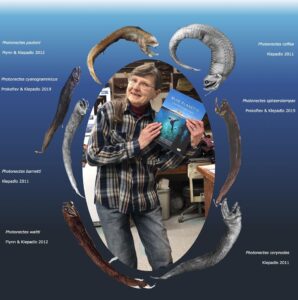 24 June
24 June
Photonectes coffea Klepadlo 2011
Many black dragonfishes (Stomiidae) are named for the shape or structure of their chin barbel. Photonectes coffea, known from 500 m below the surface of the equatorial and central north Pacific, has one of the more charming names in the family. It is named “coffea” because the bulb-like swelling at the end of its barbel resembles a coffee bean.
Last week we learned that the ichthyologist who described P. coffea — and 25% of all known species in the genus — passed away on June 3rd.
Cynthia (Cindy) Klepadlo (1945-2020) was a long-time collection manager and volunteer at the Scripps Institution of Oceanography (SIO) in La Jolla, California. She passed away unexpectedly at her home shortly after her 75th birthday.
The following obituary is by Phil Hastings, Curator of Marine Vertebrates at SIO:
Cindy was born in Chicago on May 26, 1945, and spent much of her elementary school years there. She lived in Los Angeles for her high school and early college years where she met her life-long partner Paul Merritt. They moved to Long Beach where she attended California State University, Long Beach, receiving both BS (1974) and MA degrees (1983). From 1981 to 1988 she was a Lecturer in the Departments of Computer Science & Engineering and Electrical Engineering at California State University, Long Beach.
She first came to SIO in 1985 as a volunteer in the SIO fish collection and in 1986 was a Biological Assistant in Ken Smith’s lab. In 1989 her value to the collection was recognized by then Curator Richard Rosenblatt who hired her as Museum Scientist in the Marine Vertebrate Collection. She remained in that position until retiring in 2007 but continued as a faithful and dependable volunteer in the Collection for the 13 years until her passing.
She was always the go-to person for identifying deep-sea fishes for which the SIO collection is especially well known. She single-handedly identified and cataloged tens of thousands of specimens.
Cindy was committed to helping anyone who walked in the Collection door, even when it might interrupt one of her own projects.
She served on the Collections Committee of the American Society of Ichthyologists and Herpetologists since 1992 and was the Subject Index Editor for the society’s journal Copeia since 2007.
She and collaborators described seven new species of deep-sea barbeled dragonfishes, and two new species of deep-sea swallowers.
She will be remembered for her love and knowledge of deep-sea fishes, and her willingness to teach any students who had similar interests.
The image shown here was created by Cindy’s successor, Ben Frable, the current Collection Manager of Marine Vertebrates at SIO. It shows Cindy surrounded by the species of Photonectes she described.
Ben tells us that Cindy’s favorite among the names she coined was Photonectes coffea.
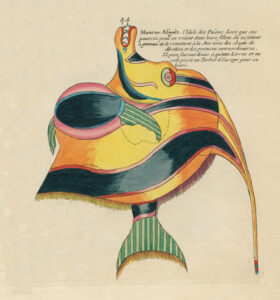
The Moorish Idol from: Renard, L. 1719. Poissons, écrevisses et crabes … aux îles Moluques. 2 vols. Amsterdam. You can browse Franz Steindachner’s copy of Renard’s book (a 1754 reprint) at the Biodiversity Heritage Library.
17 June (rev. 15 July)
Names from Renard’s book of fantastical fishes
In 1719, Louis Renard (ca. 1678-1746), French bookdealer, publisher and spy for the British Crown, made biblio-ichthyological history. He published a book featuring 460 brilliantly colored copper engravings, representing 415 marine fishes from the Dutch East Indies, plus 41 crustaceans, two stick-insects, a dugong, and a mermaid — Poissons, Ecrevisses et Crabes, de Diverses Couleurs et Figures Extraordinaires, que I’on Trouve Autour des Isles Moluques, et sur les Cotes des Terres Australes (Fishes, Crayfishes, and Crabs of Diverse Coloration and Extraordinary Form, which are to be Found About the Islands of the Moluccas and on the Coasts of Southern Lands). It’s said to be the first known book of fishes published in color (see footnote 1, below). Only 100 copies of the first edition were published. Only 16 copies are known to exist to this day.
Despite the fact that many of the illustrations are crudely made and bear little or no similarity to their living counterparts, the book represents an intriguing glimpse of what ichthyology was like in the late 17th and early 18th centuries. What’s more,
Renard (or his artist Samuel Fallours, a soldier stationed in Ambon with the Dutch East India Company), gave each fish a Dutch name. Some of these names have found their way into the scientific and present-day common names of several well-known reef fishes.
Let’s start with the Sling-jaw Wrasse, Epibulus insidiator. This wrasse uses its protrusible jaws, which unfold into a tube and can extend up to 65% the length of its head (the most extreme jaw protrusion among fishes), to catch aquatic prey, mostly small fishes and crustaceans. The generic name Epibulus, established by Cuvier in 1815, means “one who plots or schemes.” But how is this fish plotting or scheming? The answer lies in Renard’s book. He called it “Bedrieger,” Dutch for “deceiver” or “trickster.”
The Bedrieger “is very entertaining in clear water,” Renard wrote. “It is voracious and sits at the bottom like a dull fellow, but luring its prey. It has a long snout hidden in the mouth, which it throws out with great agility to capture any prey that comes too close” (translation). When not in use the jaws are tucked away inside the mouth, giving the fish a deceptively normal appearance. (See footnote, below.)
Renard was so smitten by the beauty and colors of marine angelfishes (Pomacanthidae) that he gave many of them “noble” names. “The wonderful diversity and coloring that this species [sic] of fish possesses are prodigious,” he wrote. “They are distinguished by the names royal, imperial, duke, duchess, marquis, count, baron, and other titles of nobility.”
A perfect example is the Emporer Angelfish Pomacanthus imperator (Bloch 1787), which gets both its scientific and common names directly from Renard. He called it “Keyser van Iapan” (Emporer of Japan), probably alluding to its majestic appearance. In fact, Renard called it the “most beautiful fish in the world, covered with small scales “more brilliant than gold” (translation).
The specific name of the Majestic Angelfish Pomacanthus navarchus (Cuvier 1831) means “leader of ships” and was clearly inspired by Renard’s name for it, “Admiraal.” Renard did not explain the meaning, but we suspect that it refers to the blue stripe crossing the fish’s operculum, like the blue shoulder strap of an 18th-centrury admiral.
The Moorish Idol Zanclus cornutus has one of the more peculiar common names among fishes. Wikipedia (and many other web references that cite it) say the fish got its name from the Moors of Africa, who purportedly believed the fish to be a bringer of happiness. But that doesn’t follow Renard’s explanation, who introduced the name “Moorse-Afgodt” in his 1719 book. First of all, Renard’s fish did not come from Africa; it came from the East Indies. And secondly, the term “Moor,” while often used as a derogatory term for Muslims living in Spain or North Africa, was also used for infidels or pagans (i.e., non-Christians) in general. This explanation appears to fit with Renard’s caption:
“The pagan idol. When the poor people see these fish caught in their nets they throw themselves on their knees and put the fish back in the ocean, with songs of devotion and extraordinary postures.”
Sounds like good advice for taking care of all the fishes of the sea.
Footnote 1: Scholar Holger Funk tells us that the first fish book published in color is L’histoire naturelle des estranges poissons marins by Pierre Belon (1551).
Footnote 2: The specific name of the Sling-Jaw Wrasse is the accurately descriptive, “insidiator” meaning “ambusher” or “lurker.” But Pallas did not have the benefit of seeing Renard’s brief description of how the fish ambushed its prey. Pallas, as did others of the time, believed the Sling-Jaw Wrasse slung its jaws at terrestrial insects by shooting droplets of water from its elongated snout — a feeding strategy well-known among archerfishes (Toxotidae) but not known, alas, among wrasses.
 10 June
10 June
Acanthobunocephalus scruggsi Carvalho & Reis 2020
Banjo catfishes (Aspredinidae) get their name from the banjo-like appearance of many species, particularly their depressed head and slender caudal peduncle. So it seemed only a matter of time before ichthyologists named a new banjo cat after a famous banjo player. That time is now.

Dorsal view of Acanthobunocephalus scruggsi. From: Carvalho, T. P. and R. E. Reis. 2020. A new miniature species of Acanthobunocephalus (Silurifomes: Aspredinidae) from the lower Purus River basin, Amazon Basin, Brazil. Copeia v. 108 (no. 2): 347-357.
Writing in the journal Copeia, Tiago P. Carvalho and Roberto E. Reis have described a second species of Acanthobunocephalus from tributaries of the lower Purus River in the Amazon Basin of Brazil. They named it Acanthobunocephalus scruggsi “after Earl Scruggs [1924-2012], a prominent American banjo player known for popularizing a three-finger banjo picking style, also known as ‘Scruggs style,’ which is characteristic of bluegrass music. The name of the species also makes an allusion to the common name given to aspredinid species in general (banjo catfishes), and the remarkable resemblance of the new species with this musical instrument.”
This got us to thinking about what musician-themed fish names we could expect in the future.
A guitarfish (Rhinobatidae) named after Jimi Hendrix, Django Reinhardt or Andrés Segovia?
A trumpetfish (Aulostomidae) named after Louis Armstrong, Miles Davis or Wynton Marsalis?
A drum (Sciaenidae) named after Buddy Rich, John Bonham or Ringo Starr?
A lutefish (Citharinidae) named after Nigel North? (We admit having to look this one up.)
3 June
Agonomalus jordani Jordan & Starks 1904
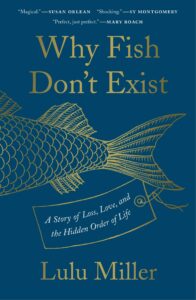 In the well-reviewed new book Why Fish Don’t Exist: A Story of Loss, Love, and the Hidden Order of Life, author Lulu Miller (a science reporter for National Public Radio) recounts her fascination with David Starr Jordan (1851-1931), the dean of American ichthyology and founding president of Stanford University. Miller starts off admiring Jordan, especially his desire to reveal the “hidden order of life” through taxonomy, and how he survived multiple personal disasters and setbacks, including the destruction of his massive fish collection in the 1906 San Francisco earthquake. But the more Miller learned about Jordan, the more she realized what a dark, troubling and odious man he was. His grandiose view of himself. His Machiavellian personality. His role in covering up the murder (by poison) of Stanford University co-founder Jane Stanford (suggesting that he may have had her killed). And, most damning, his role in promoting eugenics — the removal from the breeding pool of people deemed unworthy to reproduce. In the final sections of her book, Miller demonstrates how Jordan’s pro-eugenics writings and lectures helped pave a way to the forced sterilization of over 60,000 Americans in the name of “public welfare.”
In the well-reviewed new book Why Fish Don’t Exist: A Story of Loss, Love, and the Hidden Order of Life, author Lulu Miller (a science reporter for National Public Radio) recounts her fascination with David Starr Jordan (1851-1931), the dean of American ichthyology and founding president of Stanford University. Miller starts off admiring Jordan, especially his desire to reveal the “hidden order of life” through taxonomy, and how he survived multiple personal disasters and setbacks, including the destruction of his massive fish collection in the 1906 San Francisco earthquake. But the more Miller learned about Jordan, the more she realized what a dark, troubling and odious man he was. His grandiose view of himself. His Machiavellian personality. His role in covering up the murder (by poison) of Stanford University co-founder Jane Stanford (suggesting that he may have had her killed). And, most damning, his role in promoting eugenics — the removal from the breeding pool of people deemed unworthy to reproduce. In the final sections of her book, Miller demonstrates how Jordan’s pro-eugenics writings and lectures helped pave a way to the forced sterilization of over 60,000 Americans in the name of “public welfare.”
The book — an amalgam of memoir, biography, and social and science history — is superbly written, philosophically provocative, and suspenseful enough to be called an intellectual page-turner. Unfortunately, it contains two etymological errors that undermine Miller’s attempt to glean hidden psychological insight from the name of a fish that Jordan described.
Jordan, Miller is impressed to say, described nearly one-fifth of all fish species known in his day. One fish, however, stands out, “the only fish in the entire sea,” she says, “that David Starr Jordan named after himself” (p. 65).
The fish is Agonomalus jordani, a species of small, bottom-dwelling, cold-water marine fish distantly related to sculpins called a poacher (family Agonidae). This particular species, described by Jordan and his student Edwin Chapin Starks (1867-1932) in 1904, occurs in the western North Pacific from the Okhotsk Sea to the Sea of Japan, and along the Pacific coast of northern Japan.
Miller examined the holotype (a syntype, actually) at the Smithsonian Institution Museum Support Center in Suitland, Maryland. She writes:
An eerie quiet falls over me. I wonder why, of all the thousands of fish David encountered, that was the one he chose to name after himself. It’s breathtaking, absolutely, but frightening, too, in the way of an M. C. Escher drawing. Something about its form doesn’t seem to quite obey the laws of physics. But when you trace your fingers along its contours, searching for where the breakdown in geometry occurs, you come up empty. Indeed, its genus name, Agonomalus, comes from the Greek for “no corners.” A = without + gonia = angle, corner. Taxonomists from long ago had noticed how its kind seems to defy the laws of physics. Agonomalus jordani. Jordan of the No Corners. Like a Möbius strip, two sides, but one, somehow. The boundary between them an unfindable thing.
Why was this the creature David felt reflected him? Was there some sort of confession in the choice? Of some dark side lurking beneath the friendly man so capable of winning hearts, jobs, awards? I didn’t know (p. 67).
Miller returns to the name of this fish later in the book. On page 106 she writes:
I thought back to the eerie fish I had seen at Stanford [Smithsonian, actually], the one fish in the sea David Starr Jordan had named after himself. The spiny Möbius strip of a dragon, with two opposing sides curled seamlessly into one. Jordan of the No Corners. Was there a message hidden in his choice? A nod to a dark side underlying his charm?
These are evocative passages. And I was certainly excited to see fish-name etymologies so dramatically featured in a mainstream book! Trouble is, they are wrong. Miller mistranslated Agonomalus (it refers to joints, not corners). And David Starr Jordan did not name the fish after himself.

Agonomalus jordani, from: Jordan, D. S. and E. C. Starks. 1904. A review of the Japanese fishes of the family of Agonidae. Proceedings of the United States National Museum v. 27 (no. 1365): 575-599.
Apparently, Miller did not consult Jordan & Starks’ original description of Agonomalus jordani (freely available online). If so, she would have noticed that it was named by Russian ichthyologist Peter Schmidt (1872-1949), which Jordan & Starks clearly indicate in their account. Here’s what happened: Jordan & Starks were preparing their own description of the fish, with a different name, when they discovered that Schmidt had a description for the same species in manuscript. Apparently believing that Schmidt’s publication would come out first (it didn’t), and to avoid an unnecessary synonym in the literature, they “suppressed” the name they had “devised for this fish” in favor of Schmidt’s manuscript name: jordani. (Schmidt said he named the fish in honor of Jordan’s contributions to the study of Pacific fishes.) Schmidt’s monograph appeared later in the year after Jordan & Starks 1904 was published. Even though Jordan & Starks credited Schmidt with the name, the description itself was theirs, so the name “Agonomalus jordani” dates to Jordan & Starks even though they did not coin it. Agonomalus jordani Schmidt 1904 is now considered a junior subjective synonym and junior primary homonym of Agonomalus jordani Jordan & Starks 1904.
The etymology of Agonomalus requires a bit more work to untangle. True, a literal translation of agonos yields “without an angle” or “not angled.” But in this case “Agono-” refers to the type genus of the poacher family Agonidae, Agonus, proposed by Bloch & Schneider in 1801. Consult their description and it’s easy to see that they described a very angular fish. In fact, the first two words of their description are “Corpus angulatum.” Instead, according to Jordan himself, on page 2065 of his Fishes of North and Middle America, the name means a-, without, and gonia, joint, i.e., rigid, referring to the body plates of Agonus cataphractus, which make it a rigid, inflexible fish.
As the type genus of the family Agonidae, the name “Agonus” has been incorporated into the names of several related genera, including Agonomalus, proposed by Antoine Guichenot (1809-1876) in 1866. As Jordan & Starks clearly indicate in their 1904 paper, Agonomalus is formed by a combination of the genus name Agonus and the adjective homalus, meaning “level, even, or flat, i.e., compressed.” Guichenot helpfully explained that the fish’s compressed head and body inspired the name: “Il a, comme nous l’avons déjà dit plus haut, la tète et le corps remarquablement comprimés, d’où nous avons imaginé la dénomination d’Agonomalus, sous laquelle nous le faisons connaître génériquement dans cette notice.”
Simply put, Agonomalus does not mean “No Corners,” as Miller stated, but rather “compressed Agonus” or “Compressed No Joint.”
When you understand the true provenance of “Agonomalus jordani” — which Jordan & Starks explained in their description — there is nothing psychologically meaningful about it. There is no “confession in the choice.” It was simply one ichthyologist honoring another. It is only through the arcane rules of zoological nomenclature that David Starr Jordan is the senior author of a fish that bears his name. Yes, Jordan thought very highly of himself, but self-eponymy is a major breach of etiquette in biological nomenclature. It subjects the author to sneers and ridicule from peers and colleagues. An ichthyologist of Jordan’s stature would never have stooped so low. And why would he? By 1904, he had already been honored 22 or so times in the names of fishes. Many more were yet to come.
I sent an email to Ms. Miller explaining all of the above and she was quick and gracious in her reply. She says she wished she knew about The ETYFish Project while writing her book. And she says she will include my comments in the second (paperback) edition. UPDATE: She did, in the endnotes.
You may be curious about the book’s title, “Why Fish Don’t Exist.” What does it mean? In the book’s final chapter, Miller suggests that Jordan, who devoted much of his life to studying the “true relations” between creatures, may have been crestfallen to learn that his beloved “fish,” as a natural (monophyletic) unit, does not exist. The word is merely a term of convenience, used by people from all walks of life (ichthyologists included) to categorize a group of animals that are superficially similar but do not share a common genealogy the way birds and mammals do.
The natural world, as Miller nicely explains it, does not “arrange itself into the categories we set for it” (p. 176).
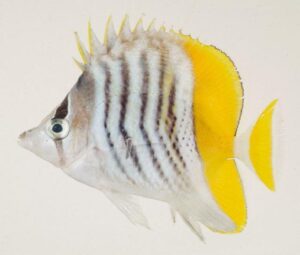
Chaetodon mertensii. Photo by Jeffrey T. Williams, National Museum of Natural History, Smithsonian Institution.
27 May
Our 35,000th name: Chaetodon mertensii Cuvier 1831
Yesterday, we reached another milestone in our quest to research the etymologies of all valid fish genus and species names, adding the 35,000th entry in our database.
Chaetodon mertensii, proposed by French naturalist Georges Cuvier in 1831, belongs to the Atoll Butterflyfish, found in deep lagoons and seaweed reefs in the Indo-West Pacific from East Africa, north to the Ryuku Islands of Japan, and south to Lord Howe Island (Australia) and Rapa Island (French Polynesia). Despite its fairly wide distribution, Cuvier had no idea where the fish came from. Nor did he even have a specimen. Instead, he based his very brief description solely on an illustration shown to him by Karl Heinrich Mertens (1796-1830), a German botanist and naturalist best known for his scientific voyages to Iceland and Russian America (now called Alaska). How Mertens came in possession of a tropical reef fish is unclear; perhaps he acquired it during one of his botanical voyages to Asia. For the act of merely showing Cuvier an illustration he was honored in the fish’s name.
Cuvier and his student-successor Achilles Valenciennes named several other fishes after Mertens, all based on illustrations, but only one of those names remains valid today. That name belongs to Thymallus mertensii (Salmoniformes: Salmonidae), a grayling from Russia. In this case, we know that Mertens illustrated the plate upon which the description was based. Whether Mertens also illustrated the butterflyfish drawing he showed Cuvier is not clear. The illustration does not appear to be extant
A butterflyfish from the tropical waters of the Indo-West Pacific and a grayling from the cold waters of Russia — that’s quite a wide geographic (and taxonomic) range for which to be honored!
(The generic name Chaetodon, dating to Linnaeus 1758, is derived from chaeto-, bristle and odon, tooth, referring to its setiform teeth, i.e., forming a brush-like bundle.)
With our 35,000th name, we have an estimated 6,400 names to go. Right now we’re reviewing and editing Order Labriformes (wrasses and parrotfishes), with 771 names. And we are well into compiling original descriptions and researching the names of Order Acanthuriformes, including the butterflyfish discussed here. We hope to complete this etymological journey, which we began in 2009, by the end of 2021.
But since new genera and species are always being described — and old taxa constantly being brought back to life — the journey will never end.
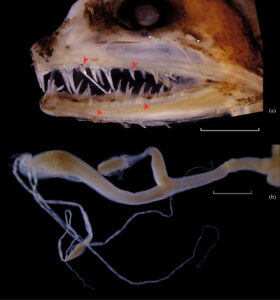
Eustomias natalisa, holotype. Top: Fixed teeth are indicated by arrows, so = suborbital luminous organ, po = postorbital luminous organ. Bottom: Chin barbel. From: Prokofiev, A. 2020. New Eustomias species (Melanostomiidae) from New Caledonia. Journal of Ichthyology 60(2): 331-334.
20 May
Eustomias natalisa Prokofiev 2020
For the 3 May 2017 “Name of the Week” we explored a sampling of arbitrary names — those in which the author coins a word or creates a word-like combination of letters that is not a latinization of an existing word (in any language), geographic location, or name of person. Sometimes there’s a hidden meaning in the combination. Sometimes there’s not. Here’s a new one that intrigued us.
Eustomias (subgenus Dinematochirus) natalisa is a scaleless black dragonfish (Family Stomiidae, Subfamily Melanostomiinae) recently described by Russian ichthyologist Artem Prokofiev from the Coral Sea of New Caledonia. It was found in a previously unstudied collection of dragonfishes collected by a French research expedition in 1965. Like most dragonfishes, it is distinguished by the structural details of its chin barbel.
Prokofiev gave this unpleasant-looking fish a rather pleasant-sounding name: natalisa. He said in the etymology section of the description that the name is formed by an arbitrary combination of letters, but we weren’t buying that. “Natalisa” sounded suspiciously to us like the name of a woman. Was Prokofiev holding back the true meaning of the name? Was Natalisa actually a woman in his life? An ex-girlfriend, perhaps? An ex-wife? Did he name this mean-looking fish with a long barbel dangling from its chin as an act of revenge for the woman who broke his heart?
We asked Prokofiev for the untold story behind the name. Alas, there is none. He told us he had simply grown weary of finding available, distinctive yet suitable names for such a diverse genus (127 species and counting). So he opted to coin an arbitrary name instead, one that sounded nice to the ear. And so “natalisa” was born.
We accept Prokofiev’s explanation for the name. But we’re not happy about it. In our minds, Natalisa is a real person. After all, don’t we all have a Natalisa (or a Nathaniel) in our past?
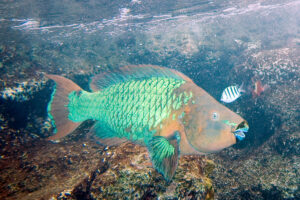
Scarus guacamaia, terminal-phase male. Photo by Paul Asman and Jill Lenoble. Courtesy: Wikipedia.
13 May
Scarus guacamaia Cuvier 1829
There’s a lot of history packed into the name of this parrotfish.
Let’s start with the genus name Scarus, fixed in ichthyology by the Swedish explorer-naturalist Peter Forsskål (1732-1763). Forsskål apparently named the genus for “skaros,” the ancient Greek name of another parrotfish, Sparisoma cretense, from the Mediterranean and eastern Atlantic. No one’s sure what “skaros” means. The best explanation comes from the French anatomist-naturalist Guillaume Rondelet (1507-1566), from the first part (1554) of his two-volume Libri de Piscibus Marinis. Rondelet said the name is from skairon, meaning to pasture (i.e., graze). This explanation appears to date to Aristotle (385-322 BC), who, in his History of Animals (Book VIII), said the Mediterranean Parrotfish was the only known fish to “chew cud like a quadruped.” Aristotle did not elaborate on this behavior; however, modern researchers believe his observation may be based on the fact that food in the alimentary canal of a parrotfish is often reduced to a pulp by its molar-like pharyngeal teeth.
Aristotle not only compared the parrotfish to a quadruped. He also was the first to compare it to … a parrot! Aristotle called Sparisoma cretense a “parrot-wrasse,” although that is a modern-day translation of his ancient Greek. Instead, Aristotle probably used some variation of Psittacae, the name he coined for a bird, probably the Ring-necked Parakeet, Psittacula krameri, noted for its ability to mimic human speech. This bird, Aristotle wrote, is “said to have a man’s tongue, answers to this description; and, by the way, after drinking wine, becomes more saucy than ever.” Aristotle’s name lives on in the names of the order (Psittaciformes) and several families (e.g., Psittacidae) of parrots and their allies. And when Forsskål assigned the first species to his genus Scarus in 1775, he named it Scarus psittacus.
Why Aristotle compared the parrot (fish) to the parrot (bird) has not been recorded, but one could easily guess that the name refers to the fish’s fused teeth, which form beak-like plates that give it a parrot-like countenance.
Which brings us to Scarus guacamaia, the Rainbow Parrotfish of the western Atlantic from Bermuda, south Florida, the Bahamas and the Caribbean to Venezuela.
Although its name officially dates to French naturalist Georges Cuvier (1769-1832), it was first proposed by Portuguese-Cuban naturalist Antonia Parra (1739-?) in his Descripción de diferentes piezas de Historia Natural of 1787. “Guacamaia” is a latinization of guacamaya, the Spanish word for macaw and the local Cuban name for this species. Parra said the name refers to both the fish’s macaw-like beak and its macaw-like coloration.
Here’s what intrigues us about this name: Were the Cubans who called this fish guacamaya aware that Aristotle compared a Mediterranean relative of this fish to a parrot? Or did they, centuries and continents apart, independently make the same comparison?
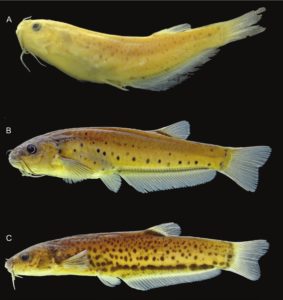
Trichogenes beagle (A) compared to the two other known species of the genus, T. claviger (B) and T. longipinnis (C). From: de Pinna, M., V. Reis, and H. Britski. 2020. A new species of Trichogenes (Siluriformes, Trichomycteridae), with a discussion on the homologies of the anterior orbital bones in trichomycterids and other loricarioids. American Museum Novitates 2020(3951): 1-27.
6 May
The catfish from nowhere
Some fishes come from the ocean. Others from rivers and lakes. This one came from a freezer.
Two weeks ago, American Museum Novitates, a publication of the American Museum of Natural History in New York City, published the description of an unusual new species of trichomycterid catfish. What’s most unusual about the fish is that no one knows where it occurs (or occurred) in nature. Three specimens were discovered in a museum jar with no collection and associated data. Yet the specimens were sufficiently preserved as to place it to genus (Trichogenes) and sufficiently distinct to know it was an undescribed species. And so the researchers named it the Trichogenes beagle for the place where it was discovered: the Laboratory of Molecular Systematics — nicknamed Beagle, after HMS Beagle, the ship that carried a young Charles Darwin around the world — at the Department of Animal Biology at the Universidade Federal de Viçosa in Minas Gerais, Brazil.
Vinícius Reis, one of the description’s three authors, discovered the catfish during a routine search for molecular samples of trichomycterid catfishes in a freezer at the Beagle lab. No one at the lab knew how it got there, nor when. The words “Cachoeira do Cobra” were inscribed by hand in pen on the outside of the vial, even though vials of that sort are often repeatedly reused and inscriptions on their outside may bear no relation with their current content. Search in gazetteers and Web resources revealed two potential candidates for a locality with that name, but field trips yielded nothing. The geographical provenance of T. beagle remains a mystery.
It’s not unusual for a new species of fish to be described with only a vague notion of where it occurs. In the 18th-century, several fishes were described from “curio cabinets” in personal natural history collections. In the 1800s, explorers and mariners often caught fishes and donated them to the museums of their home ports, usually with only the most general (e.g., “Atlantic”) field data. And in the 20th century, many aquarium fishes were described from aquaria knowing only that they were exported from tropical lands (e.g., “Amazonia” or “Malaysia”). But in most if not all of these cases, the fishes were collected again and their geographical distributions were confirmed.
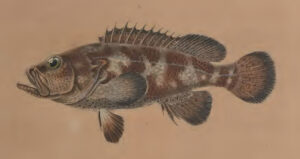
Epinephelus lebretonianus. From: Jacquinot, H. and A. Guichenot. 1853. Reptiles et poissons. In: Dumont d’Urville, J., Voyage au Pôle Sud et dans l’Oceanie sur les corvettes “L’Astrolabe” et “La Zélée”. v. 3 (pt 2): 1-56, Pls. 1-7.
But what about fishes with no collection data, like Trichogenes beagle, that have never again been seen in the wild? Have others been described?
With the help of Ron Fricke at Eschmeyer’s Catalog of Fishes, we were able to confirm the existence of at least one additional species of fish that falls into this category: Epinephelus lebretonianus, a grouper described in 1853, probably named for artist Louis Le Breton (1818-1866), who likely painted the only known image of the species (show here). It was collected during Dumont d’Urville’s second voyage to the South Seas (1837-1840) aboard the corvette L’Astrolabe (on which Le Breton served as assistant surgeon and draftsman), but no one recorded where the collection took place. It has never been collected again.
It’s called the Mystery Grouper.
 29 April
29 April
John “Jack” E. Randall (1924-2020)
In 2011, I asked Bill Eschmeyer who he believed was the greatest living fish taxonomist. He unhesitatingly answered, “Jack Randall.” For the diversity of fishes he described. For the quality and sheer volume of his published work. For his stamina in the field. For the remarkable underwater photographs he took (and shared). And for the longevity of his career, from his first paper in 1955 to a note on hybrid reef fishes published in February.
This morning I wake up to the news that Jack left us for the big coral reef in the sky on Sunday, 26 April.
I never met Jack. I knew him only briefly over email. Occasionally I would ask him for clarification or more information on one of the 834 species he described. His answer was usually along the lines of, “I’m in my 90s now, and I worked on that fish a long time ago, so I don’t remember the details …” — and then proceeded to give me the details anyway.
I suspected his health had taken a turn for the worse on 19 April. I had sent him a email about a wrasse he named and received an automated email in reply:
Dear Friends and Colleagues:
I am no longer answering emails. At age 95 I have health issues that prevent me from continuing my research.
Thank you for your inquiry and please be safe during these trying times.
Aloha, Jack
Jack Randall, who lived in Hawaii, always ended his emails with the Hawaiian word for love, affection, peace, compassion and mercy.
And now we say “Aloha” to him.
http://marineexploration.org/jack/

Quoy’s painting of Labrus (now Bodianus) perditio, showing what appears to be a juvenile or an initial-phase adult. (Terminal-phase adults are ruby red.) From: Quoy, J. R. C. and J. P. Gaimard. Poissons. In: Voyage de découvertes de “l’Astrolabe,” exécuté par ordre du Roi, pendant les années 1826-29, sous le commandement de M. J. Dumont d’Urville. Paris. Zoologie, v. 3 (Pt 2): 645-720, Pls. 1-4, 7, 10-12, 14-15, 19-20.
22 April
Bodianus perditio (Quoy & Gaimard 1834)
A hurricane throws the wooden ship you’re sailing on into a reef. It’s stuck. Natives from a nearby island lie in wait, eager to scavenge whatever debris the ocean doesn’t swallow or wash away. You’re very close to losing the ship and perhaps your life. What do you do?
You continue painting the illustration of the handsome wrasse you just collected.
That’s what happened to Jean René Constant Quoy (1790-1869), naturalist and surgeon aboard the French corvette Astrolabe during its 1826-1829 circumnavigation of the globe.
The accident occurred on 20 April 1827 on what is now called Astrolabe Reef in the Tonga archipelago, the southernmost group of islands of central Polynesia. During the four days the ship was stranded, Quoy completed his painting of the wrasse: a beautiful yellow body with a great golden saddle on the shoulder, the head and upper body spangled with golden spots, and yellow fins mixed with green. Eventually commander Dumont d’Urville was able to dislodge the ship and continue the voyage.
When Quoy, along with fellow surgeon-naturalist Joseph Paul Gaimard (1793-1858), described the wrasse in their 1834 account of the voyage, they named it “perditio,” from the masculine Latin noun “perditis,” meaning perdition or destruction.
Quoy and Gaimard were modest in explaining the circumstances behind the name and the quality of the painting (shown here). They wrote (translated from the French):
“This fish takes its name from the position in which the Astrolabe was in when it was caught. We were stranded on the reefs of Tonga-Tabou. The individual has been lost, and the design only imperfectly renders the brilliance and variety of its colors.”
15 April
Cope headscratcher #9: Metynnis
In 2014, we posted eight Name of the Weeks featuring enigmatic names coined by American ichthyologist-herpetologist-paleontologist Edward Drinker Cope (1840-1897), for whom the journal Copeia is named. Six years later we are adding a ninth—Metynnis, a genus of herbivorous and omnivorous fishes from South America distantly related to piranhas known in the aquarium trade as “silver dollars.”
Initially, we did not consider the name enigmatic. Even though Cope did not explain its etymology (per his custom) in his 1878 proposal of the genus, we felt confident in following the lead of Donald Taphorn’s Characiform Fishes of the Apure River Drainage, Venezuela (1992). Taphorn stated that the name meant “with a plow, referring to the keeled belly.” We saw no reason to disagree. The name almost certainly translates as meta-, with, and hynnis, plowshare (the main cutting blade of a plow). This translation appeared to align nicely with the serrate abdominal keel or belly of the type species, M. luna. In fact, Cope mentioned this feature, saying that the belly was “armed with spiniferous ? intrahaemal bones.” (The published text includes the question mark but we don’t know why.)
And so the etymology stood until earlier this year when we received, via our German correspondent Erwin Schraml, a 2018 article by ichthyologist Axel Zarske in the German hobbyist publication Aquaristik Fachmagazin. Zarske stated that our “keeled belly” explanation was wrong. Instead, he said, the “plow” or “plowshare” of Metynnis refers to a bone or spine at the base of the dorsal fin.
We emailed Dr. Zarske seeking evidence for this claim. He told us his etymological explanation dates to a standard German aquarium reference called Die Aquarienfische in Wort und Bild, published in installments between 1934 and 1967. The section on Metynnis, published in 1939, was written by German aquarist Arthur Rachow (1884-1960), for whom several genera and species of aquarium fishes are named (e.g., the killifish genus Rachovia). Rachow wrote:
“Metynnis (gr.); meta = mit, samt; hynnis = Pflugschar; hinsichtlich des Vorhandenseins eines Praedorsalstachels” (meta = with; hynnis = plowshare; with regard to the existence of a predorsal spine).
Dr. Zarske prefers the “predorsal spine” explanation because the presence of this spine is what Cope used to distinguish Metynnis from Myletes (now divided by present-day ichthyologists between Colossoma, Mylossoma and Piaractus). In Cope’s own words, Metynnis is “Myletes with an external cultriform spine at the base of the dorsal fin …”. Whether something described as “cultriform” (knife-shaped) can also be said to resemble the cutting blades of a plow is up for you to decide.
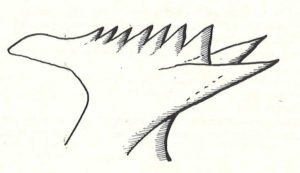
Predorsal spine of Metynnis maculatus. From: Géry (1979).
As additional evidence, Zarske presented an illustration (reproduced here) from a 1979 paper by characiform taxonomist Jacques Géry showing the predorsal spine of a related species, Metynnis maculatus. The teeth on the spine can be said to resemble plowshares. However, when we imagine a plow, we see the blades pointing down, towards the ground, not up, towards the sky. For this reason, we prefer the “keeled belly” explanation for the name, but we also acknowledge that the Rachow/Zarkse explanation has equal merit. We have since rewritten the etymology of Metynnis to include both explanations.
Of course, all this extra work and speculation could have been avoided if Cope had simply added a few words explaining the name. But where’s the fun in that?
LITERATURE CITED
Cope, E. D. 1878. Synopsis of the fishes of the Peruvian Amazon, obtained by Professor Orton during his expeditions of 1873 and 1877. Proceedings of the American Philosophical Society 17(101): 673–701.
Géry, J. 1979. The Serrasalmidae (Pisces, Characoidei) from the Serra do Roncador, Mato Grosso, Brasil. Amazoniana 6(4): 467-495.
Rachow, A. 1939. Metynnis maculatus (Kner, 1858). In: M. Holly, Meinken, H. and Rachow, A. Die Aquarienfische in Wort und Bild. Taf.: 327–328; LNr. 7D/II, 8.
Taphorn, D. C. 1992. The characiform fishes of the Apure River drainage, Venezuela. Biollania Edición Especial – No. 4. Monografias Cientificas del Museo de Ciencias Naturales, UNELLEZ — Guanara, estado Portuguesa, Venezuela. 1-537.
Zarske, A. 2018. Die Scheibensalmler der Gattung Metynnis—Eleganz im Schwarm. Aquaristik Fachmagazin 259, 50(1): 6–25.
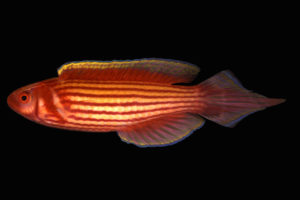
Conniella apterygia. Photo by John E. Randall.
8 April
Conniella apterygia Allen 1983
We’ve criticized FishBase several times for the many incorrect etymologies posted at their site. This one is laughably bad.
Conniella apterygia is a small (8 cm TL) wrasse (Labridae) known only from Rowley Shoals off northwest Australia, where it inhabits steep outer reef slopes (30-40 m deep) over rubble with patches of live coral. It was described as both a new genus and new species by the famous and prolific American-born Australian ichthyologist Gerald R. Allen in 1983.
The specific name, which FishBase did not address, translates as a-, a privative, meaning “without,” and pterygia, “fins.” The wrasse is named for its most distinctive feature: its lack of pelvic fins. Indeed, Allen said Conniella apterygia differs from “most other percoid fishes by lacking pelvic fins and their skeletal supporting structures.”
Here is FishBase’s attempt to explain the etymology of Conniella:
“Conniella: Latin, conicus = cone + Latin, dens, dentis = teeth”
The “Conni-/conicus” relationship we can understand (although the extra “n” is a red flag that the translation is incorrect). But how in the heck were they able to derive “dens” from “ella”? The two morphemes are nothing alike!
Had the FishBase editors consulted the original description, which apparently they did not, they would have seen that Allen had named the genus in honor of his wife Connie Lagos Allen. The FishBase editors also overlooked the fact that the diminutive suffix “-ella” is commonly used in zoological names to connote endearment.
(Note: Allen also named the Popondetta Blue-eye Pseudomugil connieae after his wife in 1981.)
Naming a genus in honor of his wife was certainly a lovely gesture on Allen’s part. What’s not so lovely is the common name — no doubt referring to its lack of pelvic fins — that Connie’s wrasse has been given over the years:
Mutant Wrasse.
 1 April
1 April
First there was the movie. Now there’s the blenny …
It seems the authors of the newly described Cirripectes matatakaro, a combtooth blenny (Blenniidae) from several Central Pacific islands, had two good ideas for its name. So they assigned one idea (based on a horror movie) to its proposed common name and the other (based on a local language) to its formal specific epithet.
The specific name, matatakaro, is a combination of the i-Kiribati words mata, meaning eye and, takaro, meaning ember or burning coal, referring to its “large, eager-seeming eyes” and to the red slashes on the blenny’s face, reminiscent of smoldering embers or burning coals. I-Kiribati (also known as Gilbertese) is the national language of the Republic of Kiribati, a nation in the Central Pacific comprised of 32 atolls and one raised coral island. The senior author, Mykle L. Hoban, selected an I-Kiribati name to honor the people and culture of Kiribati, where he first encountered and collected this new species.
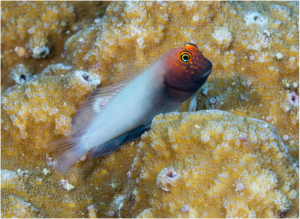
Cirripectes matatakaro, probably a female, photographed by D. Rolla at Kiritimati Island, Kiribati. From: Hoban ML, Williams JT. 2020. Cirripectes matatakaro, a new species of combtooth blenny from the Central Pacific, illuminates the origins of the Hawaiian fish fauna. PeerJ 8:e8852
The inspiration for the proposed common name comes from an unexpected source. According to Hoban and co-author Jeffrey T. Williams, “Suspiria Blenny is in reference to the color palette of the 1977 Dario Argento film of the same name.” While we had heard of this film and know that it has a cult following among horror-film devotees, we did not understand the reference. A quick Google search teaches us that Suspiria (the original, not the 2018 remake) is one of the “reddest” movies ever made, with blood-red walls, red backlighting, lots of red lipstick and nail polish, and, like many horror movies, lots of gushing, flowing red blood. Clearly, the Suspiria reference alludes to the red slashes on the blenny’s face.
The description is a free download available here.
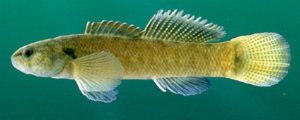
Etheostoma corona. From: Mettee, M. F., P. E. O’Neil, and J. Malcolm Pierson. 1996. Fishes of Alabama and the Mobile basin. Birmingham, Al.: Oxmoor House.
25 March
Coronafishes
The name coronavirus is derived from the Latin corona, meaning “crown” or “halo.” The name refers to the resemblance of club-shaped protein spikes covering the virions (virus particles) to a crown or solar corona when viewed by a transmission electron microscope.
Before “corona” became a “bad word” (to use my wife’s expression), it was used in the names of several fishes.
In 1850, Temminck & Schlegel described the Crowned Seahorse, Hippocampus coronatus, in their great work Fauna Japonica. The name refers to the large bony crest, or coronet, atop the seahorse’s head.
In 1924, Gilchrist & von Bonde described Plectromus (now Poromitra) coronata, a new species of ridgehead (Beryciformes: Melamphaidae) from off the coast of South Africa. The name refers to the “crenulated crown-like crest” on its head and above the eye
Shark taxonomist Stewart Springer did not explain the etymology of Sphyrna corona, a hammerhead shark he described in 1940. My best guess is that the name refers to its “irregularly oval” head, one of the two features Springer used to distinguish the species.
“Corona” can also mean rim or border. That’s how Gerald R. Allen applied the name to Melanotaenia corona, a freshwater rainbowfish from Irian Jaya, Indonesia. In this case, “corona” refers to the distinctive white margin on the fish’s dorsal fins.
In the United States, “darterologists” Lawrence M. Page and Patrick Ceas described the Crown Darter, Etheostoma corona, from Tennessee and Alabama (shown here). The name refers to the crown-like appearance of the second dorsal fin on breeding males.
Perhaps the most unusual use of the root word “corona” is in the name of the Dusky Kob, Argyrosomus coronus, a species of drum or croaker (Sciaenidae) that occurs in marine and brackish waters along the Atlantic coasts of Angola, Namibia and South Africa. Described by Marc H. Griffiths and Phillip C. Heemstra in 1995, the name honors Griffith’s wife Corona for her “contributions to the illustrations of this paper and her help with field work.” The name is a noun in apposition, so it doesn’t have the usual “ae” ending often seen in names honoring women. For some reason, however, the authors either latinized Corona’s name (turning it into coronus), or they used that spelling to agree with the masculine gender of genus (an unnecessary emendment since the specific name is a noun not an adjective).
Whatever the explanation, having Corona as your first name must be awkward in light of current events.
Stay safe. Stay healthy. And if you can or must … stay home!

Salvelinus colii. Painting by Alexander Francis Lydon. From Houghton, W. 1879. British Fresh-water Fishes. London: William Mackenzie.
18 March
Happy Saint Patrick’s Day
Yesterday was Saint Patrick’s Day, commemorating the traditional death date of Saint Patrick (c. 385-c. 461), but pretty much nowadays celebrating all things Irish. And so we feature a trio of Irish-themed fishes and their names.
Six freshwater fishes are endemic to the island of Ireland, including Cole’s Char, Salvelinus colii. Described by Albert Günther of the British Museum in 1863, the char is named in honor of Irish paleontologist and Member of Parliament William Willoughby Cole, 3rd Earl of Enniskillen (1807-1866), for his “untiring interest” in helping Günther obtain and study this fish. The English word “char” (or “charr”) is thought to derive from the Old Irish ceara or cera, meaning “blood red,” referring to the pink-red underside of many Salvelinus species.
Perhaps the most famous Irish ichthyologist honored in the name of a fish was not originally from Ireland. Born in London in 1864, Ernest William Lyons Holt studied zoology in Scotland and established himself as an ichthyologist after publishing several papers on the eggs and early larval stages of fishes from off the west coast of Ireland. In 1899, he established a floating marine laboratory in County Galway. His work helped lay a scientific foundation for fisheries research and management in Ireland. In 1918, Danish ichthyologist Åge Vedel Tåning named a new lanternfish (Myctophidae), Diaphus holti, in honor of Holt. Tåning said Holt was “the first who has ever identified a postlarva of the genus Myctophus.” In addition, marine biologist Albert Eide Parr proposed Holtbyrnia, a new genus of tubeshoulders (Platytroctidae), in 1937. The name honors Holt and his frequent collaborator L. W. Byrne, who authored several papers on the fishes of the Irish Atlantic Slope. Ill health and the changing political climate in Ireland prompted Holt to leave Dublin for London, where he died of kidney disease in 1922.
Very far away from Ireland is the home of Lobulogobius morrigu, a goby from Indonesia and Australia. Described by legendary goby taxonomist Helen Larson in 1983, the goby is named for Morrigu, an old Irish (or Celtic) war goddess. The name refers to the goby’s sharp, pointed teeth occurring in several rows on both jaws.
Lá Fhéile Pádraig sona duit!

Thyrsites lepidopodea, from: Lesson, R. P. 1831. Poissons. In: L. I. Duperrey. Voyage autour du monde: exécuté par ordre du roi, sur la corvette de Sa Majesté, la Coquille, pendant les années 1822, 1823, 1824, et 1825. Zoologie v. 2 (pt 1): 66-238, Atlas: Pls. 1-38.
11 March
Holy Snake Mackerel! — two recent name changes initiated by The ETYFish Project
When we study to the meaning of a name, we do not intend to change it. But that’s what happened when we studied the names of two snake mackerels from the family Gempylidae. Based on our findings, Thyrsites atun is now Leionura atun and Thyrsitops lepidopoides is now Thyrsites lepidopodea. It’s a complex story, so bear with us.
While compiling a list of all valid gempylid taxa, we noticed that two genera had what appeared to be the same type species: Thyrsites Lesson 1831 (type species Thyrsites lepidopodea Lesson 1831) and Thyrsitops Gill 1862 (type species Thyrsites lepidopoides Cuvier 1832). That’s a nomenclatural “red flag” since the same species cannot represent the “type” of two different genera. If “lepidopodea” and “lepidopoides” are the same species — and indeed they are (see below) — then that would mean Thyrsitops is a junior synonym of Thyrsites and that Thyrsites lepidopoides is a junior synonym of Thyrsites lepidopodea.
Here’s what happened. In 1831, French surgeon-naturalist René P. Lesson (1794-1849) penned a survey of fishes encountered by the French corvette La Coquille during its 1822-1825 voyage around the world. Included in this survey was an account of Thyrsites lepidopodea ostensibly representing both a new genus and species from the western Atlantic and southeastern Pacific. Lesson did not intend or claim to describe these new taxa. Instead, he credited the name and the descriptive material to his famous contemporary, anatomist Georges Cuvier (1769-1832), who was describing Thyrsites lepidopoides in volume 8 (1832) of the 22-volume Histoire naturelle des poissons. Our guess is that Cuvier shared his manuscript with Lesson. Since Lesson rewrote Cuvier’s text and published it sooner, he is considered the author of both the genus and species, even though he did not coin the names. For reasons unexplained, Lesson changed the spelling of Cuvier’s “lepidopoides” to “lepidopodea.”
The specific name, as described by Cuvier, refers to its similarity to the cutlassfish genus Lepidopus (Scombriformes: Trichiuridae), both genera having six enlarged teeth on the upper jaw, the first three on each side, with a small hook near their point, ending in a “half-arrow” (translation). The generic name Thyrsites is a name for mackerel-like fishes dating to the ancient Greeks. It translates as thyrsos, stalk or wand and –ites, likeness, perhaps referring to their long, fusiform bodies.
Here’s where it gets even more complicated. Cuvier — who, remember, actually did the work distinguishing and describing the taxa in question — originally placed three species in his new genus Thyrsites: the aforementioned T. lepidopoides, T. atun (based on Scomber atun Euphrasen 1791), and T. chilensis (now considered a junior synonym of atun). Cuvier did not designate a type species, but since T. atun was treated first, subsequent taxonomists (apparently unaware of Lesson’s earlier account of Thyrsites) designated T. atun as the representative “type” of Thyrsites. When Lesson published his version of Cuvier’s Thyrsites in 1831, he mentioned only T. lepidopoides, the only member of the genus encountered during the La Coquille. Since Lesson “jumped the gun” and became the unintentional author of Thyrsites, the species lepidopoides (now spelled lepidopodea) became fixed, via monotypy, as the type of its genus.
But wait! It gets even more complicated. In 1862, American ichthyologist Theodore Gill — also seemingly unaware of Lesson’s publication — decided that Cuvier’s Thyrsites lepidopoides warranted a new genus. So he proposed Thyrsitops (ops meaning appearance, referring to how the genus closely resembles Thyrsites) for that species, retaining T. atun in Cuvier’s Thyrsites. And so for over 150 years Thyrsitops lepidopoides was considered the valid name of the White Snake Mackerel found off the coast of South America from Brazil to Chile.
Until, of course, we took a closer look.
To review: Thyrsites Lesson 1831 is a senior synonym of Thyrsitops Gill 1862 and Thyrsitops lepidopoides (Cuvier 1832) should now be called Thyrsites lepidopodea Lesson 1831.
But that leaves Thyrsites atun (Euphrasen 1791) without a valid genus name! With no other available names in the synonymy of Thyrsites for “Thyrsites” atun, we wondered if a new replacement name needed to be proposed.
As it turns out, the discrepancies we uncovered had already been revealed by Australian ichthyologist Gilbert Whitley in 1951, but for some reason overlooked or ignored by contemporary ichthyologists. Whitley established the priority of Lesson 1831 over Cuvier 1832. He also noted that “Thyrsites” atun required a new genus and proposed a replacement: Leionura Bleeker 1859.
“Leionura” has a convoluted history as well. According to Dutch ichthyologist Pieter Bleeker, the name dates to an unpublished manuscript by Kuhl and van Hasselt, wherein they mentioned or described “Leionura esox,” which Bleeker listed as a synonym of Thyrsites atun. Since Bleeker was apparently the first to mention Leionura in print, Whitley credited him as being the name’s author and assumed it was the next available name in the synonymy of Thyrsites. Here Whitley was mistaken since Bleeker’s Leionura is clearly a nomen nudum — i.e., a “naked name” mentioned without a description and therefore unavailable for nomenclatural purposes. However, by resurrecting Leionura and attaching it to “Thyrsites” atun, Whitley had himself unintentionally authored the name! Authorship may be given as Leionura Whitley 1951 or Leionura Whitley (ex Bleeker) 1951 or even Leionura Whitley (ex Bleeker, ex Kuhl and van Hasselt) 1951.
The etymology of Leionura is pretty much a guess since Kuhl and van Hasselt’s unpublished manuscript is not available. We suppose that it translates as leios, smooth and oura, tail, referring to the lack of keels on the caudal peduncle, compared to prominent keels on Scomber (original genus of L. atun) and other scombrid fishes.
The specific name of Leionura atun is derived from atún, Spanish for tuna and Spanish name for this species dating to at least Löfling’s Iter hispanicum (1758).

Trachurus picturatus. Lithograph by Sarah Bowdich. From: Bowdich, S. 1825. Fishes of Madeira. Pp. 121-125 and 233-238. In: T. E. Bowdich. Excursions in Madeira and Porto Santo during the autumn of 1823, while on his third voyage to Africa. London. i-xii + 1-278, 11 pls. + 10 pls.
4 March
The fishes of Sarah Bowdich
Sarah Bowdich (1791-1856) was the first woman to systematically describe a new species of fish. We highlight her accomplishment in commemoration of International Women’s Day, this Sunday, March 8th.
Born Sarah Wallis in England, she married naturalist Thomas Edward Bowdich in 1813. They seemed the perfect couple, both attracted to nature, travel and adventure. In Paris, they befriended the zoologist (and important early ichthyologist) Georges Cuvier, spending the better part of four years learning what they could from the most famous naturalist. In 1823, Sarah and Thomas explored Madeira, the archipelago southwest of mainland Portugal. From there they sailed to Africa, arriving at Bathurst (now Banjul), Gambia, intending to go to Sierra Leone and explore the interior. However, Thomas died from malaria while in Bathurst on 10 January 1824, leaving Sarah a widow with three children.
In March 1825, Sarah published her husband’s account of the Madeira trip. She appended the account with three entries penned by herself, including one called “Zoological, Meteorological, and Barometric Observations” under the byline “Mrs. Bowdich.” (Note: At that time, in order to be taken seriously, a woman had to either publish under a male pseudonym, adopt a non-gender specific initial, e.g., S. Bowdich, or else be recognized as the “Mrs.” — and thereby extension of — a noteworthy man.) Here Sarah described and named 27 fishes brought to her by fishermen. Eight of her species remain valid today, representing the first new fish species described by a woman:
Blue Jack Mackerel, Trachurus picturatus
Offshore Rockfish, Pontinus kuhlii
Bonga Shad, Ethmalosa fimbriata
Cape Verde Mullet, Chelon bispinosus
Bobo Croaker, Pseudotolithus elongatus
Guinean Grunt, Parapristipoma humile
Bastard Grunt, Pomadasys incisus
Blackbar Hogfish, Bodianus speciosus
We regret that we cannot find any image of Sarah Bowdich on the Internet. One wonders if her portrait was ever painted, or if she ever sat for a daguerreotype. Instead we feature Trachurus picturatus from her Madeira descriptions, illustrated by Sarah herself.
After the death of her husband, Sarah returned to Paris and to Cuvier, who served as her mentor. Thanks to this partnership, she was able to study collections and libraries that few other women of her time were permitted to access. Sarah published several more books on natural history, including a work on taxidermy, a biography of Cuvier, and a beautifully illustrated guide to The Fresh-Water Fishes of Great Britain (1828-1838), as “Mrs T. Edward Bowdich.” Sarah spent 10 years on this book, carefully drawing and painting each fish fresh from the water before its colors faded. Unfortunately, the book was largely ignored by others in the field because it was by a woman.
Sarah Bowdich remarried and in subsequent years published — per Victorian mores — under the name “Mrs. Robert Lee.” In 1917, American ichthyologist David Starr Jordan, in his “Genera of Fishes,” credited Thomas Edward Bowdich as the author of the Madeira fishes.
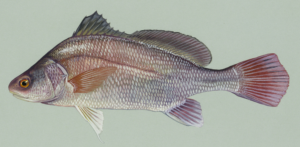
Freshwater Drum, Aplodinotus grunniens. Illustration by Duane Raver, U.S. Fish and Wildlife Service.
26 February
Aplodinotus grunniens Rafinesque 1819
A fictional fish. A broken violin. A missing “H.” A prankish act of revenge. These are the pieces of a delightful etymological puzzle.
The Freshwater Drum has the largest north-south range of any freshwater fish in North America, spanning over 40° of latitude. It occurs in the middle of the continent between the Rockies and the Appalachians, from southern Saskatchewan and Hudson Bay to the Río Usumacinta in Guatemala. Described by the eccentric naturalist Constantine Samuel Rafinesque (1783-1840), the specific name is obvious: grunniens is Latin for grunting, referring to the drum-like sounds that resonates from the swim bladder of mature males. (Rafinesque called it a growl.) The meaning of the generic name, however, is not so evident.
One of Rafinesque’s eccentricities was his poor or reckless command of Greek orthography. He either was a bad speller or “creatively” changed the spellings of Greek words to suit his fancy. The “aplo” in Aplodinotus is an example. Rafinesque did not explain its meaning. And you’ll be hard pressed to find it in any of the standard Greek or etymological dictionaries. Because it doesn’t exist.
David Starr Jordan, the dean of American ichthyology, guessed that Rafinesque dropped the “h” from either “haplois” or “haplous,” different words with different meanings. In 1882, Jordan wrote that the name derived from haplois, a “simple cloak to fit the body,” and notos, back, “in allusion to the scaly coating of the base of the second dorsal, supposed by Rafinesque to distinguish this genus from Sciaena.” Indeed, Rafinesque concluded his proposal of the genus saying that the opercles and “scaly fins” (translation) of Aplodinotus differ from the marine drum genus Sciaena.
By 1888, Jordan changed his mind. In the fifth edition of his Manual of the Vertebrate Animals of the North United States, he said that Aplodinotus translates as haplous, single, and notos, back, referring to the fish’s confluent spinous and soft dorsal fins. Perhaps the clincher for Jordan was the fact that Rafinesque reused the “aplo-“ prefix in his 1819 description of the Ohio Red-eye, Aplocentrus calliops. Rafinesque explicitly stated that the name means “single spine.”
Aplocentrus calliops is infamous for the fact that it doesn’t exist. Rafinesque was duped into describing the fish by the famous ornithologist John James Audubon. In 1818, Rafinesque visited Audubon in Kentucky. During that visit, Rafinesque is said to have destroyed Audubon’s violin by swinging it at flying bats, attempting to secure what he believed was a new species. Audubon exacted his revenge by showing Rafinesque a sketch of a kind of sunfish with a dorsal fin resembling that of the dolphinfish or mahi-mahi (Coryphaena), with a single long, spiny ray beginning behind the head and ending near the tail.
Audubon also duped Rafinesque into describing a 10-foot long “devil jack diamond-fish,” a fictional alligator gar with bullet-proof scales, and the “toad mudcat,” a fictional flathead catfish with yellow, reddish and bluish spots.
Rafinesque was more than a lousy speller. He was extremely gullible, too.
 19 February
19 February
Micropterus dolomieu Lacepède 1802
The Smallmouth Bass is one of the most popular gamefishes in North America. But for such an iconic American fish, it amuses us that its specific name, dolomieu, is distinctly French. What’s more, its generic name, Micropterus, meaning “small fin,” is one of the classic misnomers in fish nomenclature.
Lacepède selected the name Micropterus because he was intrigued by the fish’s small second dorsal fin. Trouble is, the fish only has one dorsal fin. Lacepède’s specimen was damaged. Its posterior dorsal-fin rays were detached from the rest of the fin, which Lacepède mistakenly thought was a separate fin. Compare the two illustrations shown here. The top one accompanied Lacepède’s description and show’s the small “second” fin. The bottom illustration shows what the fish actually looks like.
The description of Micropterus dolomieu dates from a time when American fishes were not yet being described by Americans. Europeans dominated biology and taxonomy, including the naming of plants and animals from the fledgling states of America. Somehow, the type specimen of M. dolomieu (possibly from South Carolina) made its away across the Atlantic to the Muséum national d’Histoire naturelle in Paris. Lacepède ignored its American provenance and named it for his fellow Frenchman Déodat de Dolomieu (1750-1801). [The name is a noun in apposition, without the usual patronymic “i” at the end.]
Dolomieu was one of the leading geologists of his day. While hiking through the Alps, he discovered a calcareous rock which, unlike limestone, did not effervesce with weak hydrochloric acid. The rock was named “dolomite” in his honor. But Lacepède did not honor Dolomieu for his contributions to geology. Instead, Lacepède was expressing joy and relief that Dolomieu had just been released from prison. France and Italy had been at war. Italy imprisoned Dolomieu when the ship he was on, caught in a storm, sought refuge at an Italian port. He spent 21 months in solitary confinement.
Lacepède said that he felt “deep pain” for Dolomieu’s “awful captivity,” and that it was “sweet” to once again hug him in his arms.
Lacepède’s joy did not last long. Dolomieu was sick when he was imprisoned, and his health deteriorated in the horrible conditions of his captivity. By the time the description of Micropterus dolomieu appeared in print, Déodat de Dolomieu was dead.
Aphanius iconii, female above, male below. From: Freyhof, J., M. Özuluğ and G. Saç. 2017. Neotype designation of Aphanius iconii, first reviser action to stabilise the usage of A. fontinalis and A. meridionalis and comments on the family group names of fishes placed in Cyprinodontidae (Teleostei: Cyprinodontiformes). Zootaxa 4294 (5): 573-585.
12 February
Aphanius iconii Akşiray 1948
Aphanius iconii is an Eurasian Toothcarp (Aphaniidae) that occurs in the Lake Eğirdir basin and nearby Lake Kovada about 4 km north of Yenice, Isparta province, Turkey. It was described by zoologist Fethi Akşiray (1916-?) of Istanbul University in 1948. He did not explain the etymology of the name.
In the first volume of his World of Killies (1993), the late killifish hobbyist and taxonomist Rudolf H. Wildekamp (1945–2019) wrote that “iconii” means “as an icon, Byzantine painting,” but did not explain how that name applies to the fish. Killifish taxonomist Jean H. Huber, at his Killi-Data website, repeated Wildekamp’s claim, adding that the name refers to its color pattern. We believe the name means something else.
Akşiray described A. iconii — originally as a subspecies of A. burduricus —from three different locations: Lake Eğirdir, the area of Çumra, and Hotamış Lake. Today, killifish taxonomists believe specimens from the last two locations actually belong to a closely related species, A. anatoliae. But these specimens are key to understanding what the name “iconii” means. They are both situated in an endorheic (closed or self-contained) basin in Konya Province in Turkey’s Central Anatolia region. The ancient name of Konya Province, dating to classical and Medieval times, is Iconium.
The name iconii simply means “of Iconium.”
The meaning of the generic name Aphanius is also obscure. Proposed by Italian naturalist Giovanni Domenico Nardo (1802–1877) in 1827, the name appears to be a Latin spelling of the Greek aphanes, which means unseen, invisible, obscure, secret, or inconspicuous. Nardo did not explain why he chose this adjective. Our best guess is that he was referring to small, inconspicuous size of the type species, which he named A. nanus (now known as fasciatus), meaning “dwarf.”
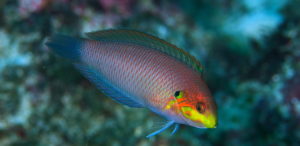
Macropharyngodon moyeri, male. Photo by Shigeru Harazaki. From: reefbuilders.com
5 February
Macropharyngodon moyeri and Synchiropus moyeri
For fishes named after people, we Google their names in order to include their birth and death dates and any other biographical tidbits we find germane or interesting. Sometimes we learn things we did not expect nor wanted to learn. Such is the case with Jack T. Moyer.
Born in Kansas (USA) in 1929, Moyer first visited in Japan in 1951 with the United States Air Force. He later moved there, earning his doctorate in marine ecology from the University of Tokyo, and founding the Tanaka Memorial Biological Station at Miyake-jima, an inhabited volcanic island in the Izu Archipelago in the Philippine Sea, in 1957. Moyer also taught at The American School in Japan, a private elementary, middle and high school in Tokyo. The school offers instruction in English and follows an American-style curriculum.
The Tanaka Memorial Biological Station has aided in the discovery of a dozen or so new fish species, two of which were named in Moyer’s honor. In 1978, Shepard & Meyer described Macropharyngodon moyeri, a leopard wrasse from Miyake-jima. The authors cited Moyer’s extensive support during their research at Miyake-jima. In 1985, Zaiser & Fricke described a new dragonet, Synchiropus moyeri, from the island. It was named for Moyer’s “noteworthy contributions to the knowledge of the fishes of Miyake-jima, and in deep appreciation of the encouragement and logistic support he has provided to both of the authors.”
Here’s where the story takes a sinister turn. In 2014, The American School in Japan admitted that as many as 32 girls had been sexually abused by Moyer from at least 1964 to 1988. The School also admitted that faculty and administration had conspired to cover up the abuse.
Moyer committed suicide in 2004 at age 74.

Neopagetopsis ionah. From: Nybelin, O. 1947. Antarctic fishes. Scientific Results of the Norwegian Antarctic Expeditions (1927-1931). v. 2 (no. 26): 1-76, Pls. 1-6.
29 January
Neopagetopsis ionah Nybelin 1947
In February 1939, during a whaling expedition to the Ross Sea, a deep bay in the Southern Ocean of Antarctica, ship engineer Nils R. Lundgren saw something unusual in the stomach of one of the whales the ship had caught. Mixed in among the masses of krill (or related crustacean) the whale had eaten, quite fresh and fairly undamaged, was a fish, 220 mm SL. Lundgren preserved the fish in a pot — “too small a pot,” remarked Swedish zoologist Orvan Nybelin (1892-1982), who studied the fish several years later — but it was the only container Lundgren could find. The pot, which also contained various preserved organs from whales, eventually made its way to the Zoological Museum of Lund University in Sweden.
Nybelin found the fish in a poor state of preservation. It had broken into two pieces and several small fragments at the point of fracture. Nybelin reassembled the specimen and prepared an outline sketch (shown here). The fish was clearly related to Pagetopsis macropterus, a member of the family Channichthyidae, often called Crocodile Icefishes, so named because they occur in Antarctic waters ranging from −1.8 to 2°C, and because their blood, lacking hemoglobin when they’re adults, is colorless. Some would say they have ice water in their veins!
With long pelvic fins and three lateral lines, Nybelin’s specimen was clearly different from Pagetopsis. And so Nybelin proposed a new generic name, Neopagetopsis, with neo– meaning new, i.e., a new genus very similar and closely related to Pagetopsis. For the specific name, Nybelin referenced the Old Testament story of Jonah, an Israelite who refused God’s calling to be a prophet and left on a sea voyage instead. Angered by Jonah’s disobedience, God raised a great storm, throwing Jonah overboard. Jonah was swallowed by a “great fish,” where he lived for three days, after which the “fish” vomited Jonah onto dry land. Thankful that his life had been spared, Jonah accepted God’s mission.
Nybelin chose the 1611 King James spelling of the name, “ionah.” The letter “j,” a relatively recent addition to the alphabet, but written as “i” in classical Latin. It was also pronounced with a “y” sound (as it still is in some languages). Classicists would pronounce the name as “yoh-nah.”

Atlantic Spanish Mackerel, Scomberomorus maculatus. Photo courtesy: NOAA.
22 January
Scomberomorus maculatus (Mitchill 1815)
We wish to point out an etymological error in the 2019 book Tunas and Billfishes of the World (Johns Hopkins University Press) by Bruce B. Collette and John Graves. On page 180, the authors state:
“The Atlantic Spanish Mackerel was named maculatus, meaning black, by the American physician and naturalist Samuel Mitchill (1815) but with no specific indication of why he chose this name. Perhaps it was in reference to the anterior part of the dorsal fin, which is black.”
“Maculatus” does not mean “black.” It means “spotted.” In fact, it’s one of the most common adjectives used to form fish names. Searching Eschmeyer’s Catalog of Fishes, we count at least 180 names in which maculatus, maculatum, or maculata has been proposed. (We did not bother to count compound adjectives, e.g., atromaculatus, black-spotted, which would up the total even more). It’s an unambiguous name that should not cause any confusion or misinterpretation.
While Mitchill did not indicate why he chose the name, he clearly described a spotted fish: “About twenty yellowish spots, some of them a quarter of an inch in diameter, decorate the sides, and impart to them a gay appearance. They are distributed about without any regard to rows.”
Collette and Graves did not attempt to explain the etymology of the generic name Scomberomorus, proposed by Lacepède in 1801. It’s a combination of the mackerel genus Scomber (from skombros, the ancient Greek name for tunny or mackerel), and [h]omorus, meaning “having the same borders with” or “neighborly” or “near.” Lacepède explained that he chose the name “designating the resemblances that link” (translation) Scomber with Scomberomorus. The same adjective, homorus, is also used in the names Gobiomorus and Atherinomorus, indicating a close resemblance and/or relationship with the genera Gobius and Atherina, respectively.
The Florida Museum of Natural History reports that the second part of the name is derived from the Greek “moros” meaning “silly or stupid.” But that’s silly and stupid.

Spotted or Trout Galaxias Galaxias truttaceus, from its original description: Cuvier, G. and A. Valenciennes. 1846. Histoire na¬turelle des poissons. Tome dix-huitième. Suite du livre dix-huitième. Cyprinoïdes. Livre dix-neuvième. Des Ésoces ou Lucioïdes. v. 18: i-xix + 2 pp. + 1–505 + 2 pp., Pls. 520–553. [As was the custom of the day, Valenciennes gave his mentor Georges Cuvier senior author credit even though Cuvier had died in 1832; Valenciennes was the sole author of the volume and the taxa described therein.]
Galaxias Cuvier 1816
Thanks to noticing a blurry footnote on our PDF of Cuvier’s 1816 proposal of Galaxias — a detail we had overlooked — we have amended our etymological entry for the genus.
When zoologist and palaeontologist Georges Cuvier (1769–1832) proposed the name in 1816, he did not tell us what it means nor why he selected it. Cuvier often repurposed fish names that appeared in ancient Greek texts for many new genera he proposed, often without any obvious connections between the ancient and modern taxa (e.g., Synodontis, Salanx, Premnas), so maybe that was the case here.
Etymologically, “Galaxias” is derived from gala, meaning milk, and galaxias, meaning milky (hence the Milky Way galaxy). This has led some to speculate that “Galaxias” refers to G. argenteus of New Zealand, alluding to its gold spots, reminiscent of stars in the night sky. We had initially dismissed this explanation for two reasons: (1) Cuvier did not mention spots nor any color markings in his brief (69 words) description, and (2) Cuvier based the genus not on G. argenteus but on a species he called Esox truttaceus.
We now believe this explanation has at least some merit since Cuvier mentioned in a footnote — the blurry, easy-to-miss footnote on our PDF — that his Esox truttaceus may be the same species as G. argenteus. Since no museum specimens exist, we have no idea if Cuvier was referring to the gold-spotted G. argenteus of New Zealand or to the brown-spotted G. truttaceus.
Although Cuvier introduced the name “truttaceus” in his proposal of Galaxias, he did not provide a description nor any distinguishing characters. Therefore Cuvier’s Esox truttaceus is considered a nomen nudum and is unavailable. Instead, authorship of the species name Galaxias truttaceus is attributed to Cuvier’s student and successor Achilles Valenciennes (1794–1865), who made the name available when he described the Spotted Galaxias in 1846. The name means trout-like, derived from the Latin word for trout, trutta. According to Valenciennes, the “rounded shape of the body and the arrangement of spots make it look like this fish is a small trout” (translated from the original French).
The meaning of “Galaxias” remains unclear. But if Cuvier’s specimen was indeed the same species as G. truttaceus, then we cannot rule out the possibility that the name refers to its star-like spots.
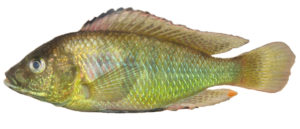
Palaeoplex palimpsest from Schedel, F. B., V. M. S. Kupriyanov, C. Katongo, and U. K. Schliewen. 2020. Palaeoplex gen. nov. and Lufubuchromis gen. non, two new monotypic cichlid genera (Teleostei: Cichlidae) from northern Zambia. Zootaxa 4718 (2): 191–229.
8 January
Palaeoplex palimpsest Schedel, Kupriyanov, Katongo & Schliewen 2020
The first genus and species names of 2020 have officially been published. They belong to Palaeoplex palimpsest, a haplochromine cichlid from the Luongo and Kalungwishi Rivers (Upper Congo drainage) of northern Zambia. The etymologies of both generic and specific names require some understanding of geoecodynamics — the study of geographical and ecological changes over time — which the authors fortunately explained.
The genus name Palaeoplex is named for “palaeoplex,” a key concept in geoecodynamics representing the total genomic variation of a given species in a given landscape. The analysis of a species’ palaeoplex theoretically allows for the reconstruction of its history. Since this cichlid is tied geographically to a very ancient landscape, with a long history in that landscape, the name refers to its scientific potential in elucidating the complex landscape evolution of that region.
The specific name is named for the palimpsest, a parchment manuscript page, common in medieval times, that has been overwritten after layers of old handwritten letters had been scraped off, in which the old letters are often still visible. The name is used here to denote that the palaeoplex of this cichlid is like a palimpsest in that it can reveal how recent changes in its landscape and/or ecological conditions affected gene flow and left genetic signatures by overwriting the genome several times, whereas remnants of more ancient genomic signatures still persist in the background.
The authors also described another new genus and species of cichlid in the same paper, but since Palaeoplex palimpsest is described first, we consider it the first new fish species of 2020. The second new species of 2020 is Lufubuchromis relictus of the Upper Lufubu River and tributaries in northern Zambia. Its names are much easier to understand. “Relictus” refers to the fact it’s a relict fish, with a restricted distribution in an isolated upper region of an ancient plateau, and a basal phylogenetic position that suggests that it represents a relict ancient evolutionary lineage that once may have had a wider distribution. The generic name is a combination of Lufubu (where it occurs) and chromis, a name dating to Aristotle, possibly derived from chroemo (to neigh), referring to a drum (Sciaenidae) and its ability to make noise, later expanded to embrace cichlids, damselfishes, dottybacks and wrasses (all perch-like fishes once thought to be related). Today, “chromis” is often used in the names of African cichlid genera following the Mozambique Tilapia, Chromis (now Oreochromis) mossambicus Peters 1852.
By our unofficial count, 12 new fish genera and 347 new fish species were proposed in 2019. Looks like 2020 is off to a good start.

Denys W. Tucker
1 January
Benthodesmus tuckeri Parin & Becker 1970
Denys W. Tucker (1921-2009) was on his way to becoming one of the most famous British ichthyologists of the 20th century. In 1960, at the age of 39, he published a letter that ended his career.
Tucker joined the Natural History Museum of London in 1946, where he quickly rose to the rank of Principal Scientific Officer and was establishing himself as a worldwide expert on eels and trichiuroids, eel-shaped fishes distantly related to tunas and mackerels sometimes called scabbardfishes, hairtails and frostfishes, including one that now bears his name. One senior academic said, “Most people who know him would agree that in intelligence he is to be classed with a few of our most brilliant colleagues.”
Tucker’s life changed during a 1959 trip to Scotland, where he claims to have witnessed an “unnamed animal” breach the surface of Loch Ness. He wrote a letter to New Scientist magazine (published October 1960), saying that the creature was Elasmosaurus, a genus of long-necked dinosaurs that roamed the earth 80 million years ago. Tucker concluded, “I am quite satisfied that we have in Loch Ness one of the most exciting and important findings of British zoology today.”
His superiors at the Natural History Museum were displeased to say the least. They believed that the Loch Ness Monster was not a suitable topic for researchers at their prestigious museum. Suddenly, questions about the heretofore model employee began to be asked. Rumors began to swirl. Did he really wave a pistol at a superior? Was he really gossiping about the sex lives of colleagues? Was his work really all that good? By the end of 1960 Tucker was fired. The reason for his removal was given as “long, continued, vexatious, insubordinate and generally offensive conduct towards the museum’s director and other senior staff.”
Tucker launched a seven-year legal campaign to retain his job. Officials wanted to shut the case down, worrying that if Tucker won they would be stopped from firing a civil servant ever again. Eventually the case made it all the way to the Court of Appeal, where it was tossed out. Tucker never held an academic post again. He lived the rest of his years in obscurity in France, where he died in 2009.
Tucker was convinced that the Natural History Museum and British government conspired to silence his claims about Loch Ness. And he was right. The coordinated efforts to silence and sack Tucker were not made public until 2015, when The Independent, a British newspaper, obtained Tucker’s file via a Freedom of Information Act request.
Oliver Crimmen, the Natural History Museum’s Senior Fish Curator, met Tucker shortly before his death. He said: “[Tucker] clearly felt there had been some sort of conspiracy… Things had got very personal, to the point of paranoia. He seems to have been an impossible character to keep within the confines of the orderly, Civil Service atmosphere… He paid a heavy price… He did feel bitter about it—you could tell he was still angry.”
As for the Loch Ness Monster? Crimmen said: “He told me he was still satisfied that the Loch Ness monster is a still a concrete material problem.”
Benthodesmus tuckeri occurs in tropical and subtropical waters of the Indo-west Pacific. The authors honored Tucker for his 1953, 1955 and 1956 papers on the genus.